How To (Actually) Get Rid Of Man Boobs
Men’s Complete Health Guide To Getting In The Best Shape Of Your Life After 35
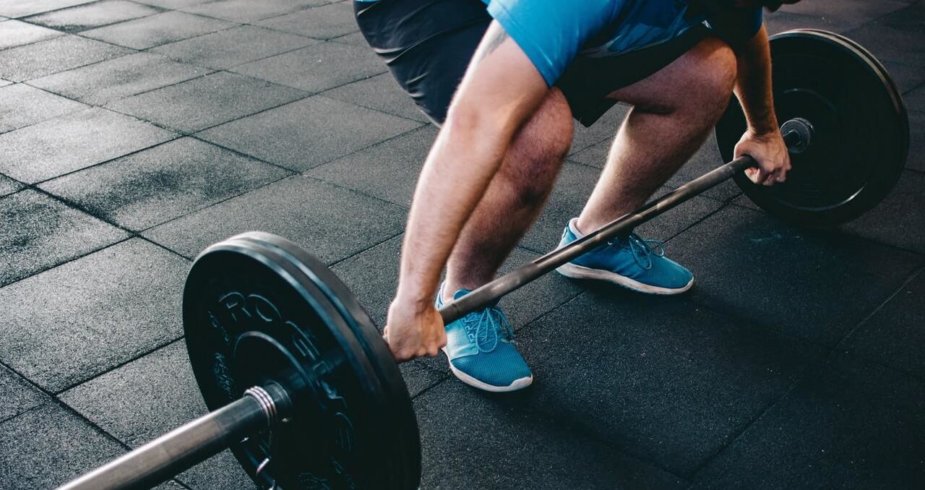
Table of Contents
-
Introduction: Getting Rid of Man Boobs
-
How This Article is Different
-
Written for Actual Beginners
-
Man Boobs Have Fancy Names, Might Just Be Fat
-
Diet vs Exercise for Man Boobs
-
2 Types of Motivation & Finding Yours
-
Diet for Life (to Shrink Man Boobs)
-
Metabolism & The Math/Science of Weight Loss
-
Don’t get stuck on precision
-
Carb Experiments: Trial, Error & Learning
-
Emotional Stomach, Insulin Issues, Obesity = Man Boobs
-
Weight Loss Arsenal: Intermittent fasting
-
Exercise (to Extend Fat Loss)
-
Exercise Principles To Shrink Man Boobs
-
Quick Testosterone Levels Detour
-
Health Progress Pics—and My Manly Boobs
-
Putting It All Together & Starting To Work The Plan
-
Footnotes & Disclaimer
Table of Contents
-
Introduction: Getting Rid of Man Boobs
-
How This Article is Different
-
Written for Actual Beginners
-
Man Boobs Have Fancy Names, Might Just Be Fat
-
Diet vs Exercise for Man Boobs
-
2 Types of Motivation & Finding Yours
-
Diet for Life (to Shrink Man Boobs)
-
Metabolism & The Math/Science of Weight Loss
-
Don’t get stuck on precision
-
Carb Experiments: Trial, Error & Learning
-
Emotional Stomach, Insulin Issues, Obesity = Man Boobs
-
Weight Loss Arsenal: Intermittent fasting
-
Exercise (to Extend Fat Loss)
-
Exercise Principles To Shrink Man Boobs
-
Quick Testosterone Levels Detour
-
Health Progress Pics—and My Manly Boobs
-
Putting It All Together & Starting To Work The Plan
-
Footnotes & Disclaimer
“Wait a minute… You got in the best shape of your life at almost 40? WTF!!!”
It’s totally attainable (even after being out of shape for nearly a decade).
Getting rid of man boobs and into shape are simple after you learn the basics.
“Simple” and “easy” are two different things though.
The media and the health & fitness industries have probably confused you and are guilty of over complicated things, they do this on purpose to keep selling you something “new” that’s not any better than the old stuff they were pushing. I’m not trying to sell you anything here—more about that later on—I simply value health and see a massive issue that is causing lots of harm and I have a dramatically different solution that works and I want to help other men feel better.
Getting—and staying—in shape boils down to getting a few dead-simple things right.
If you’re expecting “magic pills to pop” or “5 tips to lose man boobs in a month” (or within a week) with little effort on your part I’ll save you time and let you know this isn’t that kind of guide
(Spoiler: those are unrealistic paths to achieve what you’re looking for)
This guide is about getting results.
Getting quick results sounds great, but it only ends up benefiting the person trying to sell you something, since those supposed quick fixes don’t actually lead to results and are just preying on people’s insecurities and desires for immediate gratification.
Since you’re still reading it sounds like you’re willing to try something that requires some effort.
The rewards are HUGE, since we’re talking about your body, confidence and long-term health here, so it’s worth it.
Man boobs and chest fat are a problem, but getting rid of them is part of a bigger story
That story is usually about excess and being overweight (and there’s a good chance you’re part of the story, since 70.2% of American adults are overweight or obese.
I was a part of that statistic for more years than I’d like to admit and started making changes around 9 months ago that got me healthier, happier and even wealthier.
We’re not here to treat the short-sighted symptoms with a drug prescription, like the typical doctor experience that’s a revolving door in the best interests of doctors to keep us healthy enough, while not addressing the bigger problems that are time consuming and could put that doctor’s business in jeopardy.
Dependent patients are good for a doctor’s business, since very healthy people means fewer patient visits (which means less money for private schools for the kids, those massive medical school loan payments, fancy vacations, fancy cars and country club memberships for those doctors).
It’s not a quick read (since it’s complete)
This is an extremely comprehensive “article”, it’s more like a mini-book.
But it’s pure gold if you’re a man looking to get in shape (along with getting rid of your man boobs) and improving your overall health
Most of this also applies to women and young men with some minor tweaks.
What you’re going to read is the exact playbook I used to lose 30 lbs. of fat and add 10 lbs. of muscle, while feeling great and learning to eat better.
I’m considering converting it into a downloadable PDF to make it easier to read, let me know in the comments if that would be helpful.
And I’m not one of those guys that was in shape not to long ago and then put on some fat, but still had a solid base (which makes it way easier to show fake results very quickly).
I can’t promise you the same exact results, but I can promise that you’ll see huge improvements if you work the plan for at least 3 months (Warning: your results might be better, worse or similar).
I was pretty much NOT FIT for the last 3 decades—even during high school while regularly playing basketball and lifting some weights with friends in the basement—I never improved much beyond “not being fat”, except for one summer when I was a bike messenger and pedaled 5-7 hours a day, but that’s not realistic for 99% of the population as a practical fitness solution.
I lost some weight towards the end of college after doing a report on Fast Food Nation and realizing how much weight I gained from eating mostly fast food for 2 years. After cutting down on the fast food and walking more I got relatively skinny, but “skinny” wasn’t “fit”, just not visibly fat (with my shirt on).
Then I started my first full-time desk job and that’s when the big weight fluctuations started…
After a few of those professional desk jobs, marriage, having a kid and moving to Miami things got ugly and my weight started tipping past 200 lb., which was monumentally bad in my head and a wake up call—by that I mean I crash-dieted to get my weight below 200 lb. a few times, but didn’t really try to make a long-term improvement till about 4 years later (real change is hard and takes time and I wasn’t motivated or educated enough yet, since it’s so confusing and overwhelming trying to find something legit, not vague and practical).
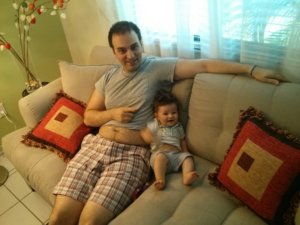
Me at more than a few lbs over 200 with my son
Being above 200 lb. just didn’t seem reasonable to me and I brought my weight down and hovered between 189 lb. and 195 lb. for the next few years.
It was losing that next 10-30 lbs of fat that would actually be the challenge and transform me into “Fit”. I’m not super-fit now, but the goal here isn’t to be super muscular and ripped like Brad Pitt. It’s having a strong, healthy body that’s man-boob free where it looks like you’re an over-the-hill former athlete that didn’t totally fall apart.
There’s still have a bunch of work and learning to do, as well as incremental physical goals to achieve, but at the age of 38 I finally feel like I “get it” and am on the right path to live longer, healthier, skinnier and happier after much trial and error.
I created this guide since I didn’t find what I wanted when looking for a way to get healthy and lose my man boobs and I needed to share it with other men on a similar slippery slope.
Don’t compare yourself to the average man…
Be cautious of bad or misleading comparisons.
Just because the “normal” that’s surrounding us—with your friends, family, coworkers, neighbors, etc.—has skewed towards the ridiculous in terms of what (and how much) to eat and how normal/acceptable it is to be fat DOES NOT mean it should actually be normal.
The real problem is systemic and it needs to be fixed, but we don’t want to wait till that happens, so we need to make personal changes.
It’s not about averages, it’s about feeling and looking as good as you can with minimal sacrifice to your long term happiness and the least amount of effort (which is different than not doing much). Lots of men overdo it trying to get results, but that’s not what this guide is about, since we’re busy and don’t want to make the center of our life exercise and diet, it’s just the foundation to build upon—we’ll use our time and newfound health for cool and interesting things of our choosing.
How this article is different (and probably better) than others out there
A foundational principle of this article (and blog) is to create independent and capable people and NOT NEED ME after you have the basics, that’s why this article is comprehensive.
It’s best read over a few sessions and not all at once (although that’s fine too, just might be too much to process if this is new to you). It’s helpful to refer back and reread parts that are most relevant to you and your current progress, and then leave a comment below with any updates of where you are with this, which is helpful for others and can also act as self-motivation.
I’m not here to sell you pills or upsell you to some “premium training program”, service, coaching, “private group” or product that actually has the answers (the supermarket, farmers and some local gyms will mainly benefit from what we’re going to learn).
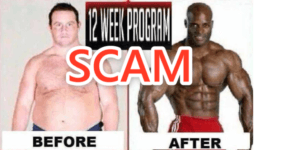
This is an exaggeration of what’s out there, but most diet and fitness products are quite deceptive and manipulative with their claims trying to sell you a fantasy
This article covers almost ALL of the information you need to get dramatically healthier and is the “prescription” I’ve successfully used over the last 9 months to dramatically transform my health through education, testing, tracking & tweaking till I found what works (and what doesn’t, which is equally important).
Another reason for the post is that I’m trying to share with and help men (and mentally flexible women) that are aging—not so gracefully—and have started to wonder how to get their health and physique back after years of neglect, but are confused or are having a hard time finding the motivation.
The biggest problem I kept hitting my head against when trying to figure things out how to get rid of my man boobs and be healthy again is that most of the articles, books and videos I was researching to figure out this “being healthy” thing is that they were written with the assumption that people following this advice had lots of self control, discipline and were mostly sane, which don’t apply to me (especially true when it comes to food and trying to get me to devote time to exercise, “Sheesh, no thanks! And I’ll have some extra mashed potatoes”).
I’m sharing what worked for me (and will probably work for you)
This is just one man’s way and experience that worked amazingly, I’m not claiming that my way is the “best” or that others are “garbage”.
It’s the resource I wish existed when I was looking, since I was painfully confused with the massive amount of bad advice and opinions being shared, numerous useless articles out there touting partial, incomplete, or impossible-to-maintain plans (or ones that are short-term and make unrealistic promises), not to mention the constant dueling “professional” and “expert” opinions battling it out.
I’m not an “expert” or “professional” in any of this stuff… I’m just a curious, regular guy who likes experimenting, research, numbers and figuring things out while stripping away the unnecessary/ridiculous and not getting distracted by all the bad data, manipulated statistics, hype and “noise” out there causing more harm than help.
I’ve done the legwork, taken in lots of ideas and research (sometimes too much, but I’m working on that), and been through the trial and error and found a flexible way of getting in shape that takes into account men being imperfect humans that mess up (sometimes a lot), but still want a solid framework to improve their health and appearance without dramatically reshuffling their lives.
A health guide for actual beginners
Another issue that you might have run into was that the resources out there make lots of assumptions about what a “beginner” is and the advice just doesn’t make sense to a real “beginner” like you (and me) without lots more research (which I did, up to a point, to make sense of “health”) and be able to figure something out that worked for real “beginners”.
A big thing for me (and probably you) was that I was looking for a plan that covered all the basics from A to Z, but concise so I didn’t have to read 300 pages to simply get started.
All this adds up to making it hard to decide which plan (or self-proclaimed “guru”) to follow and invest your effort into, so what usually happens is you end up doing nothing for a really long time…
Being confident the plan you choose will work is a big deal, since it would suck to put the effort in and not get the results you’re hoping for.

Step back to see the BIGGER PICTURE
The bottom line is I’m here to help clear up the basics of getting healthier, and I wholeheartedly believe (and have experienced) the huge improvements and value the changes I’ll outline below can make on your physical level of being “FIT”.
You can read more about the whole “FIT” & DIY” idea behind this site here, it’s probably not what you think, since I have an eclectic mix of interests and this blog is to share and explore them, not to pigeonhole myself and put blinders on.
We’re going to attack the larger fat problem and look at the BIG picture and zoom wayyyy the hell out.
Man boobs have fancy names, but it might just be fat
When extra fat is being stored over your chest the fancy word is called Pseudogynecomastia (or “man boobs” because of fat), which is different from the less common version of man boobs because of a hormone imbalance.
People hold fat in different places, it’s not just a woman thing, it’s a human genetics thing and we also hold that fat in different proportions (for our own personal body composition cocktail).
There are some rare instances when man boobs are about hormones and the balance between testosterone and estrogen being out-of-whack, that’s called Gynecomastia and is something to discuss with your doctor if you feel that’s your issue.
Please don’t read (and believe) many of the silly blog posts online on the subject and:
- DON’T Buy some BS estrogen-controlling supplement that’s probably not the “magic bullet” you’re imagining it to be, and delay the smarter course of action of checking with your doctor and getting tested OR
- DON’T Start doing things to increase your testosterone and reduce your estrogen by removing the minimal soy you’re probably eating (and other foods with tiny amounts of estrogen) from your diet OR
- DON’T Go to a plastic surgeon who will gladly slice you open for a large fee (which is a massive incentive for the plastic surgeon to give you a BS/biased diagnosis of Gynecomastia and a good enough reason that it gets overdiagnosed)
Man Boob Stats for the 2 different types
Since you’re a rational and emotional human we’re going with the available numbers, the best numbers I found are:
- Gynecomastia (related to less common man boobs because of a hormone imbalance): Anywhere between 200,000 and 3,000,000 cases per year, we’ll be conservative and use the median of 1,600,000 (or about 1% of the U.S. male population).
- Pseudogynecomastia (related to plain-old, more common man boobs because of too much fat): We’ll use the adult male obesity rate (which is different and worse than being overweight) and it’s at 32.2%
Gynecomastia cases might be 1% or 1 out of every 100 men (or even if we’re ultra-conservative and we say it’s 10x that at 10% it’s still no contest at 1 out of every 10 men).
While Pseudogynecomastia is likely to be 1 out of every 3 men (it’s probably higher now since I’m going with 2010 numbers and the historical trend has been going towards getting fatter).
The numbers are telling us that being an overweight man is 3x (or 300%) more likely than having man boobs because of gynecomastia (hormone problems). Nearly twice that at 600% if we use the “overweight” statistics instead of “obesity”, which you can learn the difference between the two here, so we’ll follow the quote:
“The greatest good for the greatest number”
—Jeremy Bentham
…And cover the more common case of just carrying too much fat over your chest or pseudogynecomastia (say that 3 times fast).
We’re going to stick to “man boobs” and not refer to them as “moobs”
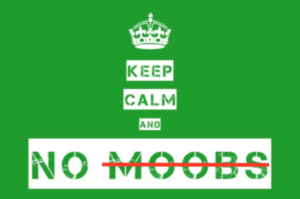 The health & diet media has started calling man boobs, “moobs” as a catchy, playful phrase, but I’m going to shy away from using that term since your health is important. We’ll make jokes and have fun in other ways though and spare the humiliation of silly terms like “moobs”*
The health & diet media has started calling man boobs, “moobs” as a catchy, playful phrase, but I’m going to shy away from using that term since your health is important. We’ll make jokes and have fun in other ways though and spare the humiliation of silly terms like “moobs”*
This man boob problem is related to so many other things and general men’s fitness and diet, so to make this guide shorter we won’t go into too much detail if we can avoid it. If there’s something that I think you don’t know and might be useful to learn more about I’ll link to that and you can fill in the information gaps you have without making this more of a monster post that it already is.
If I miss something important or you have more questions you can use the comments (also good to comment to keep me honest, humble and grounded).
Also, if I made assumptions about something I think you knew and didn’t include a link you can always Google it and then give me hell in the comments for being such an thoughtless SOB…
Ready??
Diet vs Exercise for Man Boobs
Since we’re focusing on getting rid of fat we’re going to talk diet, since that’s the place with the most potential for improvement and fat loss.
We’re talking like 80-90% of what’s needed to lose fat is related to what you put in your mouth.
We’ll also be approaching it from the angle of exercise later to tighten things up a bit (and is 10-20% of the fat loss equation).
Believe me for now that focusing on:
- Diet is like having a treasure map that you follow directly to the “X” and start digging to get the gold
- Exercise is like knowing that the gold is somewhere on Australia in this treasure example
Diet (i.e. treasure map) is way more efficient to get you to where you want to be.

We’ll still be approaching the man boob issue from multiple angles:
- Diet
- Motivation
- Exercise (to tighten things up, while putting fat-burning into high gear)
- Keeping at it by building the plan around YOU so it’s maintainable & flexible (there are trade-offs to make, but you can still make your diet and exercise interesting while getting results)
Let’s get back to diet vs exercise by sending the message home with some numbers.
A good 45-60 minute workout might burn between 500 and 700 calories, while an extra meal, drinking a sugary drink or having a carb-heavy snack can easily add 500 to 1000+ calories in a few minutes.
Let me repeat that to drill it in, “diet is key to fat loss”.
Let’s see what the basic fat loss math is so we can slay this beast!
One pound of fat is roughly 3500 calories, and to lose 1 pound a week** you need to eat roughly 500 fewer calories per day (AKA caloric deficit).
We figured that out by taking the 3500 calories in 1 pound of fat and dividing by 7 days and got 500 calories per day.
Based on your metabolic rate and your daily calorie needs, which you can easily figure out using a metabolic rate calculator, you’ll know how many calories you need to limit yourself to to hit your weight loss target (mine’s below).
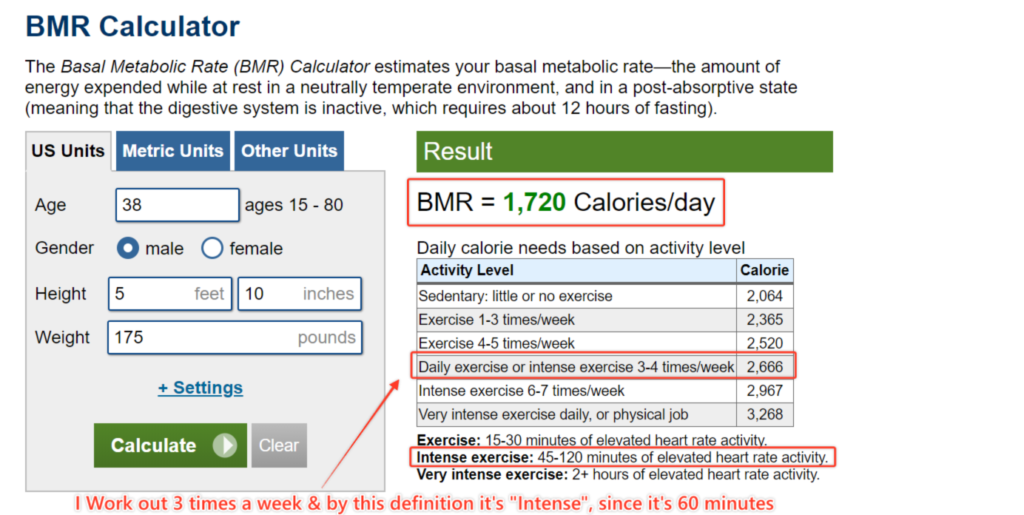
It’s not important to be super-precise with calories and your metabolic rate, we mainly need perspective to turn things around so we get roughly in the right ballpark to minimize the daily damage our diets (and lifestyles) are causing through good ol’ awareness.
Small changes and a variety of small tweaks are needed (and possibly some larger ones, depending on where you’re at healthwise), but it’s your health and wellbeing, so it’s the best investment you can make (the 2nd best investment is financial freedom, which is going to be another big focus for this blog, but that will come in future posts, so let’s get back to your body and health).
You can never have too much health, but you can have too much of lots of other things…
…But what if you need more motivation
You’re human so even though you want to achieve something there usually isn’t a clear path to achieving it.
The main reason for this is that you have to take into account your motivation, the bigger picture and how it relates to what you’re trying to achieve.
If you can’t tie getting rid of man boobs and improving your health into the bigger picture of your life and goals it becomes very easy to stop following the plan when you’re not feeling great, when you’ve missed a few workouts, when progress temporarily slows down or when you reach an unusually stubborn plateau (these are all very common and you just need to push past by being able to tap into your motivation).
Motivation is such a vague and overused word, so best to refine our understanding of it.
There are two main types of motivation:
- Internal motivation (aka Intrinsic)
- External motivation (aka Extrinsic)
It’s useful to think about which type(s) of motivation generally works for you.
Spoiler alert… it’s usually a combination of the two, but getting some insight into your behaviors, successes and failures, and the types of motivation that were in the mix during those times is enlightening and helps you more effectively leverage your motivation superpowers.
For me and getting into shape—the biggest motivation was being able to keep up with my energetic 5 year old son, play with him and not be worn out and tired while we’re at the park and needing to sit down because I get winded too easily.
I was holding roughly 30 lb. of extra fat, I felt like crap every time I tried to play with my son and was drenched in sweat and trying to catch my breath after less than a minute of running around (doesn’t help that I’m in Miami and it’s an endless summer over here, and I run hot to begin with so the conditions aren’t ideal).
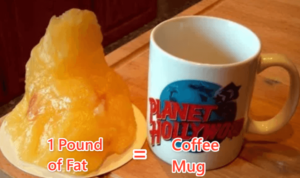
1 Pound of Body Fat Compares to a Mug. I was carrying around an extra 30 of those, how many “mugs” do you want to lose?
Add to that the pounding my knees were getting trying to handle that extra fat weight each time I took a step.
It was the perfect recipe to send the message home that something needed to change FAST!
By FAST I mean I went back and forth with the idea for months, didn’t really take it seriously and was going through an internal struggle. I half-assedly tested out some minor changes in my diet, tried to walk more, rode my bike more, and a bunch of other things that didn’t get my health and weight moving in the directions I wanted them to go. It didn’t help that I was just throwing crap against the wall to see what stuck based on reading random things online and I wasn’t sticking with any of them long enough for them to bare fruit (since it was me guessing, so why the hell would I stick to something I had minimal confidence in).
So after feeling crappy about my lack of progress I started reading more seriously about health and fitness.
After years of having no clue what it actually takes to lose weight and get into shape I finally figured out the important pieces (without having to devote my life to it).
So now I understood WHAT and HOW.
Then I looked at WHO, by reading about and talking to people that got into shape later in life and had to struggle a bunch.
After this eye-opener of connecting these ideas to real people (I personally knew), it hit me!!! I realized that if I don’t get started right now with a real effort to change it’ll continue getting worse and take healthy, active years of my life away and cause irreversible damage. This was no longer something I was willing to accept.
I also wanted to not feel ashamed and embarrassed to have my shirt off, or have a picture taken at the “wrong” angle even with my shirt on showing how big my belly and man boobs are.
So my motivation turned out to be a combination of wanting to be:
- Healthy for my son (external motivation)
- Overall health and being in shape for myself (internal motivation)
- Living a longer, healthier life (internal motivation)
- Have a body I’m proud of (internal & external motivation)
Because of this internal/external cocktail of motivation and thinking more about my past successes/failures the motivations I decided to use were:
- Internal motivation in the form of tracking my progress DAILY (I have a Google Spreadsheet with a chart that does the job. If enough people are interested in a copy let me know in the comments and I’ll gladly clean it up for sharing)
- For external motivation I made it a point to play with my son more, regardless of how I felt that day, and really paying attention to how I feel when I get too tired to play. I made it a point to deeply hold onto that memory and burn it into my brain
- And for redundancy, just in case motivation isn’t working as expected, having routines and systems for eating healthy and working out is important to help stick with it.
- For routines to eat healthy a big part is grocery shopping and making healthy food more visible and accessible (and the opposite for unhealthy foods if you can’t keep them out of the house)
- As for exercise routines having a specific schedule with the dates (or days of the week), time and place for working out highly visible and in multiple places is important. If you’re like me adding it to your phone calendar helps a lot, since your phone is almost always with you. To take it a step further you should write down which exercises you’ll be doing and how many sets and reps. It also helps to pack your gym bag and have it out in plain-sight or even better if it’s somewhere that’s in the way (if no gym bag then leave your workout clothes on the couch or somewhere else relaxing as a reminder that “admission” for relaxation is sweat)
![]()
I personally love spreadsheets and charts to keep track of micro-progress—smaller mini-goals. When you only have one really big goal that always seems too far away when looking at where you are currently and where you’re trying to get to it can be discouraging.
That’s why I like tracking the tiny units of progress you’re putting in that lead to your larger goal, since it’s good to squeeze out every ounce of motivation you can get your hands on.
It’s also useful to have incremental goals after you achieve your first big milestone. By having new health goals to work towards that are important to you—and who you are becoming—you’ll gain momentum and lower your chance of relapsing.
You should use whatever works for you to track your progress. I’m crazy and I like spreadsheets, you could be sane and hate spreadsheets and still achieve your health goals.
Some ideas for keeping track of progress (or motivation reminders) are a:
- Chart written with a pencil and paper or spreadsheet (can be just for you or displayed so others can see)
- Index card with your motivation or goals
- Picture of what you want to look like (or don’t want to look like) and your current picture (weekly pics are a good idea)
- Recurring calendar reminder(s)
- Or whatever else you come up with that gets your attention and builds urgency in you
Main thing is that it’s easy, something you update regularly, can commit to maintaining, look at daily and sends the message home for you immediately when you glance at it.
A variety of these tools and reminders really helped me, since if at any point I felt like straying from my diet too much or make excuses to be able to skip the gym that day I would look at my chart for motivation or think about playing with my son and not wanting to be the fat, out of shape dad at the park sitting on the bench and watching his son from a distance.
And those kept me motivated and accountable most of the time (and that’s usually enough).
“Variety” is important here.
Think of “Variety” as having a well-stocked weapons arsenal, redundancy or backups. It makes it harder to forget why you’re doing this, since you can’t get away from it—like a stalker, but one that’s trying to help you 🙂
All these small pieces help you redefine yourself, since a big part of the equation are things like:
- How you see yourself (as a whole person, not just a body-part you want to be a certain way)
- Which group of people you categorize yourself with and see as your peers
- How you think about yourself
- Your self-talk and the story you tell yourself about who you are
To become healthier you also need to go through the mental shift of seeing yourself in a different light, you have to think of yourself as someone that makes healthy eating decisions, someone that leads a healthy lifestyle, a person that invests in their body and stays active.
It can’t simply be a veneer or some shallow goal that’s solely about appearance, since if that’s what’s mainly driving you it probably won’t be enough to get you past the obstacles that will inevitably pop up.
To work it has to be bigger and aligned with the smaller goals (e.g. getting rid of your man boobs, lasting longer in bed or being able to keep up with your son). Aiming to be strong, healthy and active, while extending your life is a better place to start, since it requires a very large mental shift in how you define yourself, which helps you with all the necessary decisions and actions that will follow to make this slow, but meaningful shift in redefining you and your lifestyle.
It’s easier to take the potato chips out of the shopping cart and put them back on the shelf and spend a few minutes searching for a healthier substitute if you suddenly remember you’re trying to make better food decisions because you’re trying to be the healthiest you’ve ever been. These micro-decisions (and actions) trickling down from your much bigger goal start popping up more often, become automatic over time and lead to huge long-term changes.
Back to you and your motivations
To figure out what your motivations are to lose your man boobs and get into better shape you need to think about your past and what’s worked for you (and what hasn’t) for anything from personal, professional and anything else challenging in your life…
And then dig deeper and think about what was motivating you during those times and assign your hunch of what type of motivation (i.e. internal or external) was driving you during those specific challenging moments in your past.
For some writing freely works or making a list or mindmap, or anything that helps you get your ideas out of your head and on a piece of paper (or screen) to get more perspective.
After you have some ideas of what types of motivation worked for you (and which didn’t) then you can use that to experiment with different types of motivation to get a better understanding of what’s really motivating you to get into shape.
Then use that to fuel you and constantly refer back to it, or if it’s not working scrap it and try something else.
Persistence is key, you can fail a bunch of times and still achieve your larger goal if you persist and make course corrections along the way.
It’s important to write your motivation(s) down and put it somewhere that’s visible, some people like to put it on a piece of paper or index card on the mirror or fridge, but if you’re like me and like some privacy with your goals and issues you’re trying to overcome you can put it in your computer, phone or calendar.
In addition to the spreadsheet and chart, I like to create a recurring calendar event with a reminder of my goal and my motivation for it (or my “Why”).
You might have found a pattern with your motivation types already. If not, it’s not something to fret about, maybe you won’t find a pattern today or tomorrow, but even thinking about it now gets the gears moving in the back of your brain and you might come to a “spontaneous” realization about what motivates you a month from now.
It’s fine coming back to this or thinking about it for a while.
Let’s assume you’re onto what motivates you—even if you have to pretend for now…
Some people benefit by making their goals and/or motivation public, sharing it with loved ones or an exercise partner or keeping it as your secret (since putting the pressure on like that isn’t for everyone).
I chose to share my goal to “get in the best shape of my life” buried at the bottom of a few social media posts and also shared it with close friends and family if the topic of weight, health or fitness came up.
I preferred not relying on an exercise partner since it:
- Can increase the time in the gym
- Requires more effort coordinating schedules
- Gives you an easy out if your gym partner decides to abandon ship
For others having a gym partner (that’s motivated, lives nearby and has a similar schedule) can be exactly what they need, as long as they’re not a dependency that can stop you from working out if your partner stops working out or misses a session.
I don’t personally do group/partner exercise, but Crossfit—and similar—are really good since if you’re externally motivated and like a little competition with some serious group support a CrossFit group could be a good fit since they usually do big, functional movements that hit most of the criteria we’ll discuss in the exercise section. There’s also the added benefit of having a schedule and some social pressure.
A downside to typical CrossFit is it’s pricey, so if you’re frugal or on a tight budget you might want to find an alternative or create your own CrossFit group with a backyard gym of your own (or make a gym out of a public park).
The important part is figuring out why you’re doing it, so when you’re too tired to go to the gym, want to throw that big bag of chips in the grocery cart or want to eat more sweets/carbs than you’re supposed to you can quickly refer to “Why” you’re doing this to help make the healthier decision that you won’t regret and aligns with the version of yourself you’re working towards.
Optional Challenge: If you’re a little odd, like me, you can occasionally use the inevitable moments like these as a trigger to challenge yourself by adding an extra set of your most challenging exercise or eating nothing instead and fasting to get further ahead.
Don’t wait till things are perfect and you’ve figured everything out to start
There’s no value in waiting till you sort all this out to start.
Action and making mistakes are great ways to get the balls rolling in the right directions as you process things and figure out your way.
If you wait to take action now you’ll keep finding reasons to avoid taking the small steps needed to achieve your goals.
Start today!
Starting small and small wins help change your perception of yourself, your habits, gives you positive momentum. So your first step(s) for today could be as simple and small as:
- Download MyFitnessPal and start tracking your meals
- Taking before pictures of yourself
- Deciding to walk around the block every day
- Measuring your chest
- Deciding on a goal to lose 1 inch from your chest 8 weeks from today (small goals help with getting started, since big goals take longer and create mental roadblocks)
- Commit to doing as many push-ups as you can in 30 seconds, 2 times a day till you figure out a more fitting exercise routine
- Look up a few gyms nearby and schedule visits to check them out to get a feel for them
- Write your goal on an index card and tape it to the mirror
- Sharing your goal with someone
- Take a picture of the foods in your fridge and cupboards that you eat most to later compare to the diet we’ll get into below
 There are a bunch of other tiny first steps you can take to get a trend started in the right direction and build up your momentum—like a tiny snowball rolling down a hill that becomes a huge 250 lb. ball of snow by the time if reaches the bottom.
There are a bunch of other tiny first steps you can take to get a trend started in the right direction and build up your momentum—like a tiny snowball rolling down a hill that becomes a huge 250 lb. ball of snow by the time if reaches the bottom.
Small actions over days, weeks, months and years grow to huge achievements, you just have to keep patiently taking those small steps and in a year when you look back your life will be totally different and improved.
Diet for Life (to Shrink Man boobs)
As mentioned earlier, diet is the most important part of fat loss (80-90% of it), so if you want to start with just one thing (although I don’t recommend it), it’s the big one to put more of your energy into when starting out.
By “diet”, I mean eating good for life, not some temporary, ridiculously restrictive or weird-ass diet that you do for a few weeks (and are relieved when it’s over, so you go back to your old ways and are back in the same place in 2 months).
We’re looking for an overall change in how you eat. It has to fit into your life.
I learned this the hard way after multiple weird diets. One that comes to mind is where on my nights to cook dinner I was making one dinner for me and a totally different dinner for the rest of the family—which was a total pain in the ass. I couldn’t keep up with it long-term and ended up putting all the weight back on after failing with that one, even after achieving the lowest weight on that diet that I’ve been in the last 5 year (beating that weight is part of my current incremental goal).
We need to eat real foods, think the stuff on the perimeter of the supermarket, like:

Some healthier food options that are tasty and filling
Protein
- Meats that have been minimally processed, preferably chicken, fish, pork (with a smaller portion than what’s normal for beef to not give the environment the finger)
- Eggs (everyone should love eggs! Yolk and all! Egg whites also works, but I like to add at least one yolk if going with whites)
- Cottage cheese, plain yogurt (go with Greek yogurt since it has more protein than regular, and since it’s plain you can add your own flavors/toppings to it and avoid lots of unnecessary sugar), good cheeses (no Kraft Singles or Velveeta)
Fats
- Nuts & seeds
- Dark chocolate (70-85%)
- Oils and other good fats (coconut and grapeseed oil are very versatile, you can even use coconut oil like butter and spread it on bread, also olive and avocado oils are winners)
Carbs
- Beans, beans and more beans (I use parts of the 4 Hour Body Slow-Carb diet, which I highly recommend reading the chapters relevant to your goals. I get a large portion of my carbs from legumes. My favorites are black beans, pinto beans & lentils)
- Additional good carbs are usually helpful for days (or the day before) you’re doing hard physical work/workouts, since they’re a great energy source when you’re upping the intensity. As you know from above beans are my go-to, but I also recommend eating:
- Quinoa
- Brown or wild rice
- Non-wheat crackers (my go-to Mary’s Gone Crackers)
- Corn tortillas (I just get the regular Mexican ones, but they also make fancy sprouted ones)
- Wraps (with fiber and no added sugar, read the ingredients and nutrition info)
- The occasional bread (multi-grain or sprouted, no Wonder bread for me anymore or breads full of added sugar or enriched or bleached wheat flour. Please read the ingredients since 90% of packaged bread & wraps that I’ve read the ingredients of are total crap)
- Occasionally pasta or noodles (I still love me some crap Ramen noodles, probably a combination of the delicious MSG and emotions/memories from high school)
Vegetables & Some Fruits
- Vegetables & greens (no potatoes or other high starch and low fiber vegetables, the occasional sweet potato is okay and then becomes a treat since you’re slowly changing your perception of sweet to be more like whole foods and not processed/refined crapola)
- Fruits & Berries (whole, with the fiber and not just juiced, since when you juice it it’s pretty much straight sugar and spikes your insulin/glucose levels hard and fast. Try to limit this category, since even whole fruits have lots of natural sugars)
Or put differently, you want to be eating the stuff that someone that lived 100 years ago (around 1919) would recognize as (good) food.
As an added benefit to eating better, it will also change how hunger strikes you and how you respond to it. If you are like me before I started eating better I’m guessing your hunger pangs feel very intense and urgent, which is an easy way to make emotional decisions and end up eating stuff you’ll regret. More about this in the section about “Your Emotional Stomach”.
Quick calorie reduction by watching what you drink
One of the best (and simplest) ways to cut loads of unnecessary calories is to stop drinking calories… no juices, sodas, sweetened teas or coffees (I’m pointing at you Starbucks, with how you’ve fooled millions into more socially acceptable sugary drinks that are just as bad as soda, while adding the twist of paying excessively for the luxury of a “treat”).
I know it sounds hard, but it’s worth it, and after a while you’ll get used to not drinking calories on a daily basis and not even crave your old ways. And then when you have the rare sweetened drink it becomes a special experience because of its novelty (I still drink a Coke or a Starbucks “Sugarccino” on a rare occasion, I’m talking like 2 to 4 times a year, don’t want you getting the wrong idea, but know that it’s okay to deviate).
Diet drinks & soda with zero to very few calories are also out because the artificial sweeteners don’t actually satiate you like sugar does, causes insulin production (bad) and conditions us for eating ridiculously sweet foods. The research shows that you usually get hungry shortly after and eat more food in the next few hours than you otherwise would have, leading to more calories eaten for the day.
If instead you had water and a healthier snack that was more filling you wouldn’t eat the extra snack that diet drinks inevitably lead to.
For most people’s weight loss goals it’s not so important to be too anal or precise here, the main thing is that you’re eating better foods, which are filling and don’t lead to crashes, premature hunger and intense hunger pangs and avoiding the worst offending foods/drinks.
Protein as a priority
To feed your muscles and to avoid losing precious muscle along with the fat you need make sure that you’re getting plenty of protein, since it’s the main “ingredient” your body uses to repair and grow your muscles.
Some people regularly track their protein, or say you need 1 gram of protein per day per pound of muscle if you’re looking to grow big muscles, I just let my body guide me and if I’m hungry I eat (and if I’m still hungry I’ll eat more) and end up falling somewhere between 60 and 100 grams of protein a day and on training days this goes about 20-50 grams higher because of a protein shake and increased appetite.
Don’t forget to include Good Fats in every meal
I won’t go too far into this, since it’s a topic that needs it’s own dedicated post to cover thoroughly (so Google it if you want to learn more).
But the basics here are to follow some Atkin’s, Keto or Mediterranean diet ideas of fat being good, as long as it’s a high quality fat, no need to go overboard though.
The bullets above in the real foods to eat list (under “Fats”) covers the basics in the “good fat” category.
Quick tip for fats: If you’re eating dairy or meats (mainly talking about beef or pork) and they’re not organic, grass fed, pasture raised, free range or similar it’s best to get low-fat (or fat free) or lean and then add fat to the meal with one of the good fats listed above.
There’s no rule saying you have to get the fat in a self-contained package, like a cut of meat or slice of cheese, you can mix things up and create healthier combinations with minimal compromise in taste.
Another way to not drive myself crazy with diet, which is like heresy to foodies and the media, is that I eat very similar meals/foods almost everyday. I simply combine them in different ways, use seasonings and sauces (mostly hot sauce or salsa without added sugar, pasta sauce works too) to make different egg and chicken dishes, or I’ll eat lots of broccoli for a few days (or weeks) as my green and then when I need to mix it up I’ll switch to green beans.
Most meals include spinach or kale and of course my lovely beans, and it’s all drenched in olive oil.
Regarding snacks and “snacking”
Most people don’t need to eat snacks. It’s the lazy way food companies figured out how to get us to eat more (and increase revenue), by making us think we need to eat more via “fill-in” meals mainly containing bad carbohydrates and fats, sugars and salt (that we’re pretty much programmed to gorge on from evolutionary survival).
Fake “health” food brands hopped on the same boat and marketed bars, cookies and other snacks pretending they healthy and aren’t sugary treats, by using artificial sweeteners, only highlighting the good ingredients and hoping you don’t read—or understand—the ingredients (kind of like a resume, where you’re putting a positive spin on things and leaving out any negatives).
Some great examples of fake health foods are granola, veggie chips, most sweet yogurt and trail mix, they might contain some okay ingredients, but the bulk of energy is coming from crap grains, sugars or unhealthy fats.
Another fun fake health food fail was the fat-free treat Snackwell’s cookies adding fat back, since people who ate them were still getting fat since they had similar calories to other cookies, just from carbohydrates and not fat calories.
Look at the chart (orange and light orange lines) showing the explosion of obesity from the 1980s to early 2000s
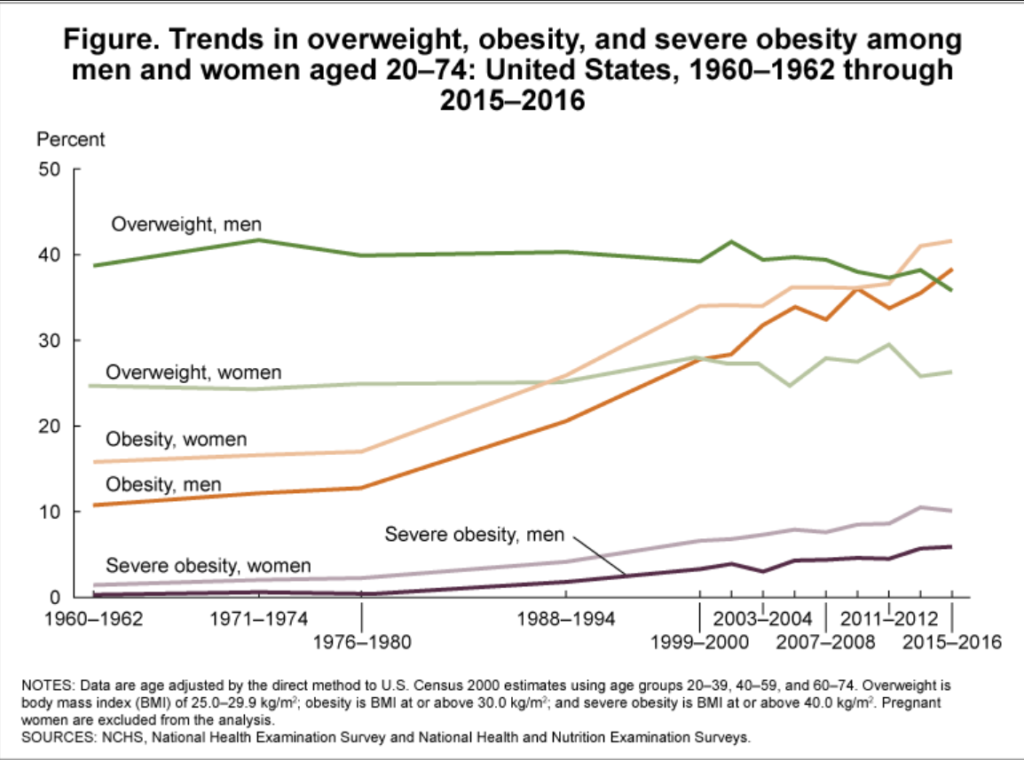
(source: https://www.cdc.gov/nchs/data/hestat/obesity_adult_15_16/obesity_adult_15_16.htm)
It’s a good practice asking yourself what the economic interests are that led to a widespread behavior change you’ve notice take place since you (or your parents) were kids, a few examples are I didn’t snack all the time as a kid, I also didn’t carry around bottles of overpriced filtered water, instead I waited for mealtime or got one healthy snack after school or a bag of cut-up carrots/celery on the go (my parents were immigrants so they were a generation behind in terms of snacking and less susceptible to media influence). Regarding water, I used water fountains or asked for a cup of TAP water (OMG!!), I’ve gotten soft and now I usually filter tap with Brita at home.
For most people minimizing snacking is an effective way to cut unnecessary calories while having 2-3 bigger meals a day instead. Some folks with blood sugar issues might benefit from many small meals throughout the day to maintain a steady insulin level, but that’s the exception, not what the majority of people need.
If you Have to Snack
Try some cottage cheese, a handful of nuts/seeds, a spoonful of unsweetened peanut butter or dark chocolate (a few squares of 70% to 85% are filling, easy to carry around—watch out for melting—and satisfying since they’re full of good fat with a hint of sweetness.)
With chocolate and peanut butter you can hack the associations planted in your brain that they’re a treat, even without the tons of sugar (like in Hershey’s version of pretend “chocolate” or sugary JIF), while slowly changing your perception of “sweet”. All this while shedding fat and having to re-introduce yourself to the belt holes you haven’t visited in years.
After eating better foods for a few months and cutting down on the sugar and processed garbage, what you find sweet will change dramatically, and then if you slip (like we all do) or have a planned cheat meal/day and eat some of the processed stuff it will be an interesting experience, since there’s a good chance you’ll find it way too sweet for your new and improved palate, while still enjoying it, but eating less of it.
Notice that I’m not giving you a specific diet or a meal plan, since there are many different types of diets that work for different people and you need to do a little experimenting to find something that will work for you long-term. I have my little ways that I cheat (with minimal harm and usually beneficial) and foods I really like and foods I don’t, so I expect you to have your own preferences (I can’t give those to you).
I’ve given you basic eating principles and a starting point to craft your own diet.
The problem with most diets is that they’re boring, strict and hard to maintain, this is the total opposite, the main principles of this are:
- Eat good, whole foods
- Find a healthier way to eat for life that you enjoy & can maintain
It has to be something YOU can MAINTAIN.
It’s YOUR diet, not someone else’s.
That’s why this isn’t called the “Fit DIY Dad” diet, it’s the “[YOUR NAME HERE]’s Diet”
If you have specific questions about the diet put them in the comments and I’ll do my best to help, or others can chime in.
Temporarily Counting Calories to Put Food Back Into Perspective
Right now you might be thinking, “Oh, nooooo!!!”
But calorie counting is eye-opening and temporary while getting a handle on how much you’re eating vs. how much you actually need to eat, which grows overtime if left unchecked (and most people, even the “experts”, have no clue how many calories they’re eating till they count them for a short period).
If you can eat healthy’ish and keep your calories in the right range without any help that’s great and you need to take a bow, since you’re in the minority.
What I found most useful to roughly get an idea of what I was eating and how many calories I was shoving down my throat was using the free MyFitnessPal app (has Android & iOS apps).
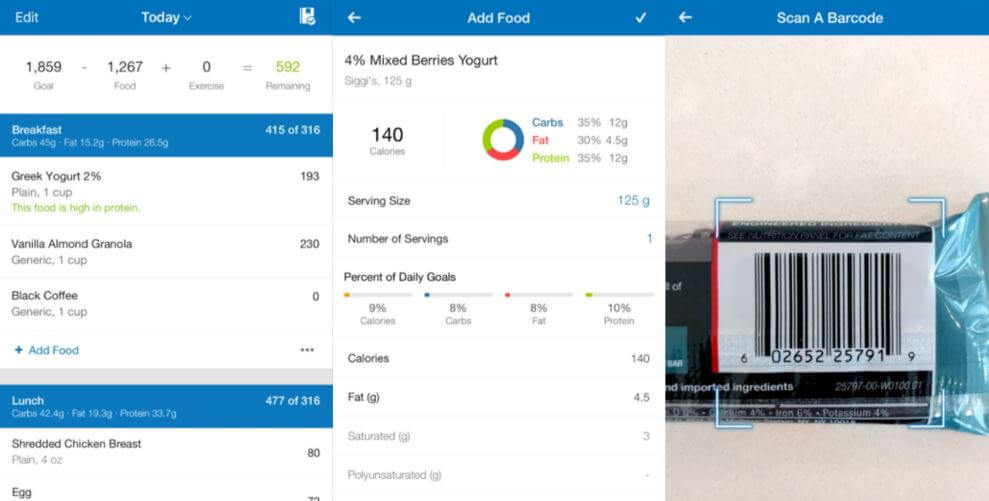
The same way I use Mint for my finances (very useful expense tracking app) & Personal Capital to understand my investments, I use MyFitnessPal to understand my eating habits and patterns.
You’ll need to track all your food for a week or two while you tweak how much you’re eating, your diet and more importantly your grocery shopping (that’s the biggie).
Grocery shopping is the gateway to your eating habits. It’s much easier to control what you eat by not bringing it home in the first place.
If lots of bad foods are in the fridge and cupboards staring at you and calling your name it’s too easy to get back to your not-so-healthy eating habits.
It gets a little harder with a family or partner, but if there’s someone else’s junk food you can try to separate it so it’s less visible or accessible, like if it’s in the fridge discuss if you can put it in the drawer or a tupperware container and label it like “Treats/Snacks for [WIFE/CHILD/ETC], Bad for [YOUR NAME]” or if it’s on a shelf do like you did with roommates and label who the owner is (or whose shelf that is and get your own shelf).
Once it’s in the house and you’re having one of those weak moments that we all have it’s way too easy eating some junk food, and then a little more… While adding 500 to 800 calories for that day from “just a little snacking”. But even if you temporarily lose control make sure that you do your best guesstimate to track it in the app so you know what just went into you.
Important: If you fall off the wagon—even for an extended period of time—with your eating or exercising forgive yourself and take a step (even a small one) to quickly get back on track and build up positive momentum. It’s very human to make mistakes, give into urges, want a break.
Don’t let a temporary mishap derail your long-term progress, we’re talking about your health, happiness and achieving your goals, no need to bathe yourself in guilt or make yourself feel crappy with negative self-talk.
It happens to all of us, to succeed you need to move past these tiny hiccups, see if there’s anything you can test changing to help the next time it happens and persist.
To drive the message home check out what 500 calories of healthy vs unhealthy food looks like (and 200 calories comparisons).
Here are two good comparisons:
200 calories (Small McDonald’s fries OR a plate of mini peppers):
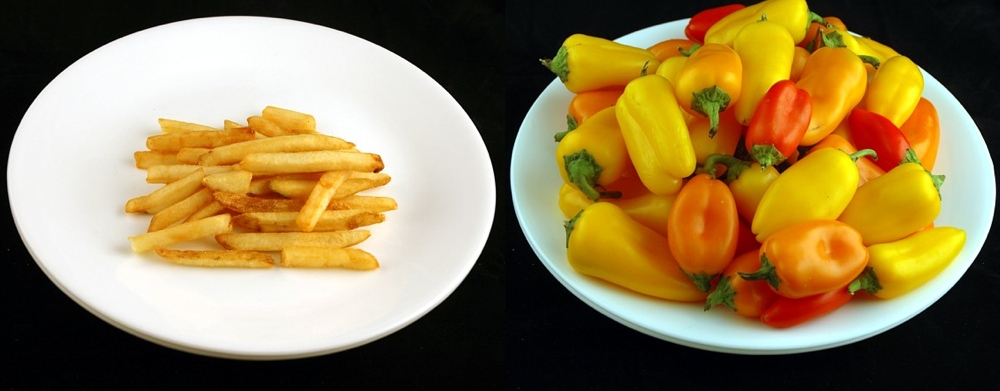
If you’re like most people you don’t get the Small “baby size” fries, you get the Medium (340 calories) or the LARGE (510 calories)
(source: https://www.zmescience.com/other/feature-post/calories-different-foods/)
500 calories (Dunkin Donuts multigrain bagel w/cream cheese OR 6 Eggs, the bagel is the unhealthy one):
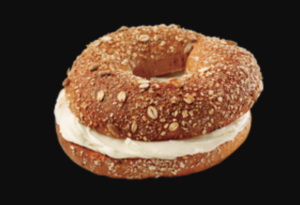
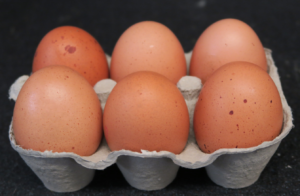
Healthier 500 calories
Chicken & Asparagus w/Cream Sauce (I would add half cup of black beans, drench in olive oil, some hot sauce & salt/pepper):
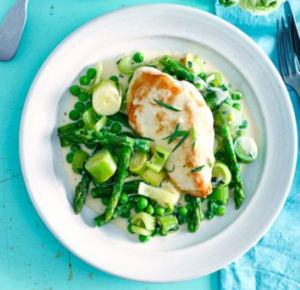
Toast w/Egg & Half Avocado (I would use sprouted bread, add another egg, raw baby spinach, drench in olive oil & salt/pepper):

IMPORTANT: I’m not saying your meals should be 500 calories or that these healthier meals are the diet I’m proposing. I’m simply—and quickly—showing a comparison of calories so these “mysterious calories” we’ve been hearing about for decades become more tangible with things you can reference.
Once you start counting calories you’ll be amazed out how making a few slightly different food decisions during a day will make the difference between “enough” and “too much”, like if you’re:
- Making a sandwich or bagel, making it open face and saving the other slice for another day/time to save between 75 and 120 calories
- Eating mexican opting for the burrito bowl instead of the burrito and saving 200 calories from the burrito wrap, choosing brown rice instead of white and either getting the sour cream or the cheese, but not both and saving another 100 calories and/or getting extra guacamole instead
- Ordering a salad at McDonald’s and where you’re choosing between the grilled or fried chicken on top, go with the grilled and save 170 calories
Once you start paying attention to calories and figuring out the alternatives that are still tasty with 95% of the satisfaction as the unhealthy option, you start to realize it’s not that big of a deal and you start a positive habit that’s eventually on auto-pilot without having to actually count calories anymore.
Your Calorie-Counting To-Dos:
- Count your calories for a week (or two) so you understand, and really pay attention to what you eat. Since when we just eat whatever we want, whenever we want we lose awareness of what’s actually being eaten. By doing this you gain awareness and take back the controls and become an active participant in your eating, which will eventually turn into a good eating habit for life
- Look over your calories and foods you ate daily and weekly to familiarize yourself with the calorie numbers
- Write down the good eating decisions you made that you want to continue making, and try to identify the bad food decisions (you can usually zero in on those by looking at the days you go way past your calorie target), and these are the ones you want to avoid in the future, think about 1 or 2 alternatives or different decisions you could have made that would have helped you hit your daily calorie target and write those down
- Refer to what you wrote down over the next few weeks at the same time everyday, preferably in the morning before any serious eating happens and you have 45 seconds of “you time”. It could be while you’re on the toilet, while you warm up the car, on the bus/train to work, at a red light or while you eat breakfast, the important part is to read it the same time and place every day till these decisions become automatic
Defend your diet at parties & social gatherings (with easy rules and planning)
You need to have your guard up at parties or get togethers with finger foods.
I personally estimated (multiple times) what I ate at get togethers the next day to figure out how much I ate and sheesh are those numbers high!
Not to mention those damn Superbowl parties…
For each it was something like 1400 calories minimum, sometimes it was twice that or more (which is why I am not writing that number out)
So now you know I like to pig out at parties (and buffets) and I still fight that battle, but I overdo it less now because of the awareness, so I’m still winning the larger war.
It’s really hard to tell how much you’re actually eating when you keep adding a little here and there and then eating it and then eating some more…
A few fried mozzarella sticks, veggies & dip, chips, salsa, pretzels, sausage, cookies (hopefully Oreos), wings, some cheese, crackers, a few tiny sliders, some cake, ice cream, a beer or two and so on…
And all of a sudden, with minimal awareness you’ve eaten enough calories within an hour or two to cover ⅔ of your daily calories (and you feel like crap).
To limit the damage here either:
- Have this as a planned cheat meal/day (a decision made before you enter the party door, and if you overdo it then skip any other cheat eating that week)
- OR Use a plate, fill it once with a nice meal-sized portion and try your best to stick to the “whole foods” idea, and that’s it… Okay, one Oreo cookie and one beer, but that’s it for the night besides water. If you’re really feel hungry after 30 minutes then go find your dark chocolate or nuts you have in your pocket (BTW, remember to pack those!)
Mentally prepare to control yourself and stop eating sooner than your surroundings, friends or eyes tell you to stop and let you stomach be the one giving you these signals after a good 20-30 eating pause to give time for the full signal to reach your brain.
Visualize beforehand that you’ve reached your limit, made the switch to water and still have an amazing time with others, the food and drink are secondary (although they’re pretty damn good and sometimes I put the eating before everything if the spread includes my weakness foods—ice cream, chocolate pudding, Oreos, chicken wings).
Metabolism & The Math / Science of Weight Loss
What we’re about to cover is really important and needs to be burned into your brain…
(OR atleast re-read a few times if you’re not into “brain burning”, better to become a pro “calorie burner”)
You burn the most calories just running your bodies systems (and not dying).
That up there was it. Reread it.
That’s what people are talking about when they say they have a “fast / slow / crazy” metabolism.
HEALTH TRIVIA
Q: Which part of our body is the biggest resource hog?
A: Our brains, they weigh about 3 lb (or 2% of total weight), but burn 25% of the calories our bodies use.
(Source: This interesting tidbit is from a great book I’m reading called “Sapiens”).
Our metabolism is just like our cars miles per gallon (MPG), humans burn/metabolize calories at different rates, just like different cars burn their gasoline fuel at different rates:
- Honda Fit, 34 MPG
- Ford F-150, 16 MPG (less than half of the Fit!! Ridiculous that the F-Series is the best selling car, yes “car”, in America and beats out the 2nd best by over 160,000 cars, and the top 3 are all damn pickup trucks)
- Toyota Prius Hybrid, 51 MPG
Humans MPG (or basal/resting metabolic rate, BMR or RMR for short) don’t normally vary as widely as cars MPG, but the idea is the same, we need to burn “fuel” to function and the higher the rate we burn our fuel (in the form of burning calories), the better, just like cars (did you pick up on me being a car guy?)
BMR & RMR are measured differently, but in the end they tell a very similar story, so for simplicity let’s assume they’re the same and use them interchangeably.
Let’s use me as an example, as a 175 LBS male I burn about 1700 calories a day just by staying alive.
(These calorie numbers are coming from the BMR calculator we used towards the beginning of the article)
When you factor in my activity level my body needs about 2,600 calories/day to maintain my weight.
That 2,600 calorie number is really important. That’s how much we would be eating each day if we were at our target weight. Since we want to lose weight we can use that 500 calories/day caloric deficit we mentioned earlier to lose 1 pound per week.
To lose 1 pound a week we’ll take 2600 and subtract that 500 and get 2100 calories a day as our daily calorie target (and limit).
And since we already covered eating healthier we don’t have to get into the discussion of “Why can’t I just eat 2100 calories of ice cream and cookies?”, since you could still lose weight that way, but you’d probably feel pretty crappy, have lots of hunger pangs and not improve your long-term health.
The great thing is that we can speed up our metabolism in:
- Small ways by brainstorming ways to move your body a bit for a few minutes every hour (e.g. by not sitting so much, taking the stairs, walking around the block for lunch or just moving around a little more than the average sloth) OR
- BIGGER ways by working out with resistance training (my favorite being free weights, with big, functional movements. More about that below in the exercise section)
More on the “BIGGER ways” to jumpstart your metabolism
A benefit of having more muscles is we’re increasing our average metabolic rate 24/7 (which is the amount of calories our body burns running the basic human systems). Since your body burns more calories maintaining muscle than fat.
Let’s look at the numbers:
- One pound of muscle burns 7 to 10 calories per day
- One pound of fat burns 2 to 3 calories per day
So changing your body composition from one lb. less of fat to one lb. more of muscle will yield you 4 to 6 more calories burned each day.
This might not sound like a lot, but it’s just an added benefit you get to enjoy every single day (which amounts to 1825 to 2190 calories per year for a one pound change).
Let’s look at a hypothetical example of two different people that weigh the same but have very different body compositions to demonstrate:
Big Jim
Big Jim is 177 Lbs with 31% body fat (Breaks down to 55 lbs of fat and 122 lbs of muscle) and his:
- Fat burns 110 to 165 calories/day
- Muscle burns 854 to 1220 calories/day
- Daily total calories burned (muscle + fat): 964 to 1,385
- Annual total calories burned: 351,860 to 505,525
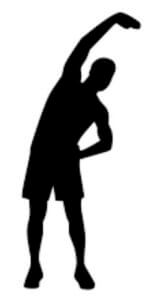
Healthy Harry
Healthy Harry is 177 Lbs with 18% body fat (Breaks down to 32 lbs of fat and 145 lbs of muscle) and his:
- Fat burns 64 to 96 calories/day
- Muscle burns 1,015 to 1450 calories/day
- Daily total calories burned (muscle + fat): 1,079 to 1,546
- Annual total calories burned: 393,835 to 564,290
Annual difference in calories burned for Big Jim vs Healthy Harry (due to his body composition with less fat & more muscle):
41,975 to 58,765 more annual calories burned for Healthy Harry
Let’s simplify and take the median of 50,370 and call it an even 50,000
This is basically “fat insurance” for the person with more muscle and less fat, in addition to all the other benefits associated with being in better shape, the fitter person has an extra 50,000 calories per year (or 137 calories per day) to use as he pleases.
Annually, this amounts to an extra:
- 66 meals (750 calories per) or
- 324 beers (154 calories per) or
- 161 slices of Domino pepperoni pizza (309 calories per) or
- 88 Big Macs (563 calories per)
And this would be while maintaining his weight.
Healthy Larry is probably not eating any of the stuff above on a regular basis, since it runs counter to what got him to where he is. If he slipped up a few times a month it wouldn’t be a big deal since he’s got this reserve of calories to use as he pleases. Most likely it’ll be used for the occasional cheat meal or day, but more often it’ll be used to further improve and burn more fat and add more muscle to continually get further ahead.
Big Jim, with quite a bit more fat and less muscle, doesn’t have “fat insurance” (he didn’t see that option on his Aetna policy) and any little eating slip up will cause more harm and fat gain. Since he already eats a little too much most days and occasionally he goes overboard, he keeps adding more than a few pounds each year that he can never seem to burn off with all the crash and fad diets he’s tried.
For people that are more anal than me, yes I realize that the body is not made up of just fat and muscle, there’s bones and tubes and other things I have no interest in inventorying. I could have used the same amount of muscle for both and added more fat to one, but this is the way I chose to do it for the sake of highlighting a pretty huge difference, so the lack of precision should be forgivable.
It’s biology and science, which are not really precise to begin with. Even if there’s a number published somewhere it doesn’t mean it’s 100% accurate, it’s someone’s best guess and if we begin debating about tiny details we lose sight of the bigger picture and waste time and energy when we could be improving our health (more on precision further down).
Lifting weights and building muscle becomes your best weapon from an exercise perspective to get rid of man boobs (and keep them off, since it’s like compound interest and it snowballs and leads to exponential fat loss and improvements when combined with diet).
You probably think I’m going to give you a bunch of chest exercises to lose those man boobs, but exercise is a tool to build muscle in a specific part of your body and fat is a totally different system (let me repeat that… Muscle & Fat are two totally different things and systems).
Fat is just a layer of (mostly) unwanted flesh on top of your muscles, so you don’t need to focus your exercises on the area you want to lose fat from to lose fat there (it’s confusing and might be the opposite of what you’ve heard others claim as fact).
Fitness & Fat Myth-busting:
You might have heard people say that “fat turns into muscle” when you exercise, this is incorrect, muscle is one thing and fat is something totally different. Indirectly it can be stretched to be the truth since fat is your bodies way of storing extra energy for future use, so that fat energy could be fuel to run your body while you’re exercising, but it’s not like fat transforms into muscle.
Just think about a rotisserie chicken or a steak and the parts that are fat vs the leaner parts that are muscle (like the chicken breast).
You usually peel or cut the fat/skin off and it can be separated, fat’s that separate thing that’s attached to the muscle, could you imagine that piece of fat turning into that chicken breast/muscle? Probably not (unless you’ve got a very good imagination).
Don’t get stuck on precision (or “perfection”)
We all have varying degrees of crazy when it come to being anal and precise, for the most part we need to temporarily ditch that to gain some weight loss momentum to see the bigger picture.
It’s probably not a matter of a small change in calories and diet that needs to be addressed. It’s likely something massive, but easy to overlook due to old habits, social norms and the passing of time, which tends to increase the amount of calories you’re consuming, while decrease the amount of physical activity you’re doing (sad, but mostly true, and you have a choice to be a part of the majority or be in the healthier minority).
Because of this massive opportunity there’s no point killing yourself with ongoing tracking and being accurate to 10-20 calories or picking one type of cheese or the other with slightly more/less calories in MyFitnessPal’s food database (just pick one and get on with it).
Little insights here will lead to massive changes in awareness of what’s actually going into your body, which will lead to motivation to improve in big and small ways that will lead to meaningful changes in your long-term health and life.
Better to track and be a little off than feeling a need to be overly precise, which will drive you to either not doing it at all or getting too crazy with it (which will lead to burnout and not being able to maintain a routine, and the routine you put in place will help you stay on track and helps when motivation isn’t doing it).

We need to get into the right “ballpark” to start things off, it’s okay if you’re off by a few hundred calories a day, eventually you’ll have your meals figured out and be able to listen to your body better once you’re not eating so many crappy carbs and sugars.
This means tracking your food is just a temporary tool to gain awareness and not something most people will have to do long-term (for some it’s useful though, I’m not one of them, but it’s something I still occasionally do for a few days to a week if I reach a plateau that’s taking longer than I’d like to pass and I can’t figure out why).
Sly carb-slinging food companies & the realities of what brought us here
(Spoiler: It’s not your fault, you’ve been a guinea pig in the processed food industries food science and marketing experiments)
This brings us to carbohydrates.
The reason we have so many bad carbohydrate options is that they’re cheap and abundant for food companies—because of government welfaresubsidies for farmers—they’re shelf stable and can be stored before processing for long periods of time without refrigeration.
Those are some of the major economic reasons you’re offered so many carbs, it’s not because they’re good for you, it’s about profits margins.
You shouldn’t be basing what you eat on cash crops (e.g. wheat, corn, soy, etc…) being:
- Flexible manufacturing inputs, where the same few cash crops can be “rearranged” into different chemical compounds designed to get plugged into a production line and taste delicious (while having you craving more, similar to an addiction)
- High yield and resistant to pests and diseases via genetic modification by guys in lab coats with little regard for health implications
Again, big food companies are looking to get you to eat more, that’s their outdated business model of making more of these $$$, without risking their “golden goose” by actually trying to go healthy (instead they change packaging and a few ingredients to trick you into thinking it’s healthy, but when/if you read ALL the ingredients you learn that most of time it’s still total crap).
The food scientist working at these companies also know the right buttons to push based on evolutionary programming to have us binge on this crap, so they experiment with combinations of salt, fat, sugar, calories, contrasting textures, mouthfeel, “crunch” and a slew of other factors to get us finishing a bag of chips instead of having restraint.
It’s usually a bad idea to let the profit motive of companies define your diet and your overall health and well-being. Same goes for fad diets, shakes, etc.
Warning: the health industry is highly lucrative because of manufactured confusion about this stuff…
…which leads people to pay ridiculous amounts for “solutions” (that don’t deliver the goods).
The health industry prospers by confusing people, once you get down to getting healthy it’s pretty simple, but they can’t sell you simple, it’s not good for their bottom lines.
So they keep churning out complex stuff that makes you dependent on them and not get lasting results because they’re mostly impossible to maintain.
Once you figure out the important pieces and stop listening to all the noise out there you get a sense of the hoax and can finally relax about having a way to get healthy (for life).
The hard part is making trade-offs and compromises, which the snake-oil salesman lead you to believe you won’t have to make if you buy their product, that they claim is “totally revolutionary” and the “last product you’ll need to buy”.
Media companies also feed on this confusion by offering you the latest fad diet or trend (the message they’re sending to folks that are paying attention is that the previous 1,000 articles they published were rubbish, which is a good indicator that these new ones will also be garbage in a few weeks once the new new article comes out).
Forget all of that!!!
These media companies get paid more with more eyeballs and newness. If they have nothing new to report they make less money, and those writers and the editors above them don’t want to get laid off, so they keep churning out this useless, incomplete stuff.
I’ve worked with LOTS of paid writers and most are super nice and great people, but most are paycheck to paycheck and will write whatever type of stuff they’re told to write. Keep this in mind next time you’re reading that Huffington Post, Muscle & Fitness or Men’s Health article or some other random post you stumble upon that’s overpromising.
Carb Experiments, Trial & Error and What I Learned

Not my laboratory, but it’s extremely important to do your own experiments to find what works for you. I’ve done dozens of my own carb experiments and sharing my findings here.
Back to carbohydrates, I’ve experimented with carbs, low carbs, no carbs, slow carbs.
It’s insane (and enlightening to learn) how different the hunger signals your stomach sends you are when you’ve eaten a meal that’s primarily processed carbs versus a healthier meal with protein and good fats being the core of the meal, while including veggies and unprocessed carbohydrates with fiber.
After a carb heavy lunch including bread, mashed potatoes, rice, pasta or similar I’ve noticed than my stomach is basically screaming at me with hunger—sugar-energy from glucose running out—which leads to eating more carbohydrates.
If my lunch includes eggs, greens, olive oil and whole beans (i.e. healthier with unprocessed carbs that don’t hit the bloodstream as quick and hard) when the hunger hits afterwards, it’s much more subtle and logical.
The carb-induced hunger feels like an emotional outcry of my stomach yelling at me in a panic to:
“Feed me right now!!!!!!!!!” and maybe something like “I’ll die if you don’t give me something this instant! Let’s eat those cookies and chips over there”
In contrast, the inner voices of hunger from the healthier diet are more like:
“Hey, I’m getting a little hungry we should think about what we’re going to have for dinner or a healthy snack”
Emotional vs Rational. Entirely different. Choose wisely.
Your Emotional Stomach, Insulin Issues, Obesity = Man Boobs
When that emotional stomach is yelling at you that it’s hungry you usually continue the cycle, by giving it more carbohydrates. This becomes your “normal” so you don’t realize how bad it is. The endless loop goes something like:
Eat Carbs/Sugar > Full > Crash > Binge on Crap > Full > Crash > Rinse & Repeat…
(Eventually Diabetes and/or obesity follow, since you’re slowly losing your sensitivity to insulin, which is a hormone)
Below is the typical eating pattern and insulin levels of lots of unhealthy people eating 3 meals plus 3 snacks.
You get what looks like a chart of big and small “mountains”, or ups and downs of your insulin levels caused by meals and snacks, with few blue “lakes”—baseline insulin levels—which is where the fat burning happens when the body switches to fat for fuel instead of carb/sugar sourced glucose fuel. The fat-burning is severely limited to two small “lakes” after dinner and while you sleep (notice the late night snack on the right, getting in the way of some serious fat burning):
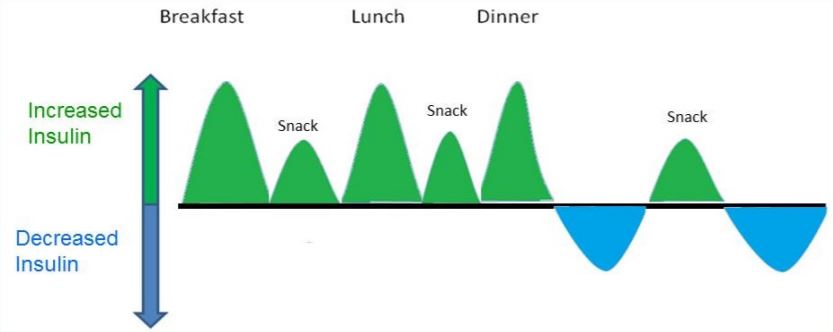
Now let’s contrast the above to your insulin levels and fat burning when you limit yourself to 3 meals (and no snacks) with the chart below.
You get less frequent insulin spikes (“mountains”), where you give your insulin levels the opportunity to get back to baseline, even for two brief periods during the day. The most fat-burning occurs during the much longer period after dinner and during your sleep (when you don’t have a post-dinner or midnight snack), and you insulin levels here look like a big, deep “lake” where you’re running your body on fat (i.e. which is really good and turning you into a fat-burning machine):
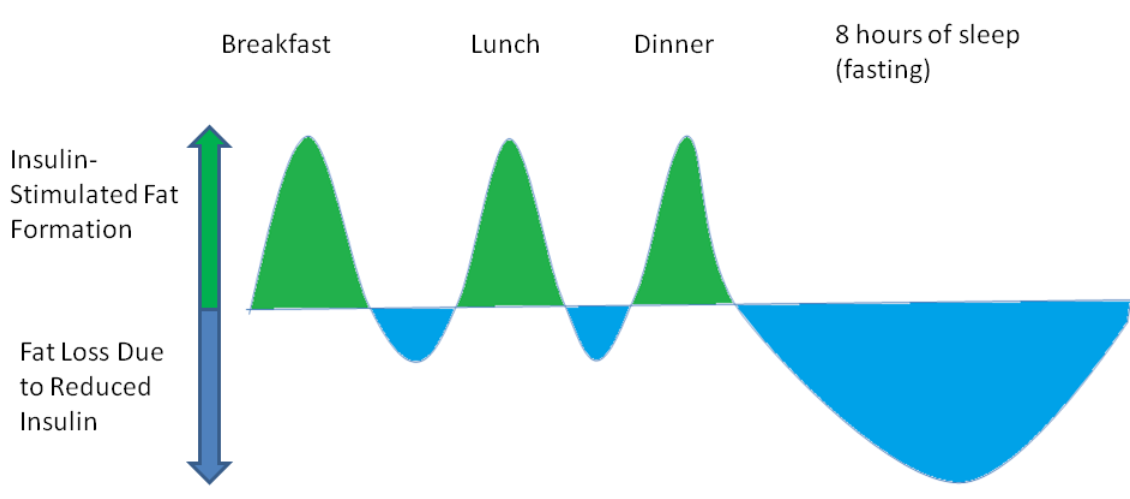
The eating pattern with snacking is also what leads to lots of newly minted fat people and diabetics, it’s amazing how big of an impact meal timing has. By being aware of this and controlling your insulin levels you’re better armed to be healthier (and skinnier).
That vicious-insulin-cycle with snacking leads to adding a few pound of weight every year instead of burning it as energy. Due to this you’ll easily follow the same slippery slope I did and have added 20-30 useless lbs. of fat over a 10 year period, and then shrug it off as “part of getting older” and a given, instead of empowering yourself and seeing it as a choice (just one that’s currently lacking awareness).
Now’s the time to make positive choices that reverse that pattern of weight gain.
Don’t listen to your coworkers, family or friends if they’re out of shape and overweight, they also accepted an incorrect truth. Healthy men are NOT destined to get fatter and unable to be active as they age.
Between long work commutes, eating out, eating garbage, sitting all day in-front of a computer, sitting (or laying down) most evenings in-front of the TV/iPad/social media and being passively entertained we’ve totally threw our bodies an unnatural curveball since our bodies and muscles were meant to be used, not neglected.
We descend from physically active hunter-gatherers that ate a wide variety of good foods (and some foods that poisoned them to death or gave them insane diarrhea).
Our amazing human bodies have been anatomically similar—just like hunter-gatherers—for the last 200,000 to 300,000 years and evolution has been doing a pretty damn good job of taking us to this point.
But our diets have diverged dramatically from what it was designed for (from 200,000+ years of evolution) with modern agriculture, industrialization and messing with food—via food science.
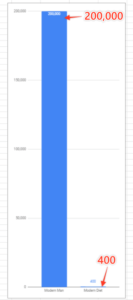
To get a sense of 200,000 (years of evolution) vs 400 (years of modern diet) and how small that is. If you squint you may see the 400
Let’s get a little perspective on the history of evolution, food & modern diets…
- Our human bodies have been anatomically similar for the last 200,000 years
- Agriculture only existed for the last 10,000 years
- Pasta’s been around for less than 900 years
- Pie & hot-dogs: 400 years
- Industrialization during Industrial Revolution about 220 years
- Donuts & mustard: 200 years
- Crackers & the can opener: 150 years
- Ice cream, hamburgers & cereal: 130 years
- Gum, pizza & chocolate bars: 110 years
- Cookies: 100 years
- Chicken nuggets: 70 years
- Modern wheat (using mutation breeding) about 60 years
- French fries, waffles & chicken wings: 50 years
- Genetically modified foods (starting with tomatoes) about 25 years
Even if we start at hot-dogs, donuts and pie as the time of our “more modern” and crappy diets started, we’re only talking about 400 years of eating like this.
400 years is is a really short period of time when considering the 200,000+ years of human evolution that’s got us to this point.
We’re talking a mere 0.2% of the time (compared to the 99.8% time or 199,600 of 200,000 years our bodies have been just like this), no wonder as a whole our bodies are not doing so well, it’s a food experiment that went horribly wrong since the folks “driving” were pretty much “drunk” and trying to delivery immediate gratification and create food habits to get rich quick.
If we go to the 1980’s when processed crap really took off or the 1990’s when genetically modified foods hit the scene we’re talking about an even shorter amount of time where they’ve pretty much kicked our diets in the balls, broke its nose, spit in its face and then pissed on it and gave it the finger with the huge about-face we’ve taken with what we eat to pretty much say us modern humans know what’s best, forget evolution that’s taken place over 200,000 years, let science and food companies take over in deciding what’s best to fuel our bodies.
Add to that how we earn our livings…
Modern work involves LOTS of sitting, and with the growth of “knowledge workers” and desk jobs there are more people sitting of their asses for longer periods of time than ever before. Americans are sitting an average of 13 hours a day and when you add sleeping 8 hours, that’s 21 hours a day where you’re body is inactive or 88% inactive time and only 12% active time.
Here’s the kicker, hunter-gatherers worked less than us at somewhere between 15 to 40 hours a week (depending on which study you look at) and their worked doubled as active time, so they moved around for work, moved around while socializing in their communities, and didn’t have computers/phones to be inactive in-front of for large parts of the day.
Looks like white collar workers—and knowledge workers—made a huge sacrifice and chose money, status and current consumption at the expense of becoming “fatties”, their health and well-being.
But all hope is not lost, this can be used to create awareness that can help us improve our diets and active time. And 12% of active time—or 3 hours of moving around—is pretty easy to beat, so the bar is set really really really low, so any motion after you’ve gotten up from your seat is going to a good cause, your health and longevity.
And with insulin and what we eat that’s even easier, so we can take it a step further…
There’s a tool I like to use that’s really helped get my insulin levels under control, while burning my stores of body fat and it’s called “intermittent fasting” and it takes the pattern of 3 meals with no snacks even further. It’s sort of like buying life insurance at a really good price, but instead of the policy paying out when you die it gives you extra healthy years of life.
If you want to learn more about obesity, weight loss and insulin, Dr. Jason Fung wrote an excellent book, “The Obesity Code”, he’s also in a bunch of YouTube videos and documentaries that you can search for on the topics of “insulin”, “intermittent fasting”, “diabetes”.
Weight Loss Arsenal: Intermittent fasting (optional, but useful)
Intermittent fasting is a great way to reduce insulin, eat fewer calories, save time (and money) and supercharge losing weight.
You have to figure out what works for you and tweak as needed by testing different diet variables, that’s why I list this as “optional”, but it’s definitely worth considering and testing out.
I heard about it from a friend 6+ years ago, but I didn’t know much about it and it sounded weird and had the word “fasting” in it, so that didn’t go anywhere.
Then fast-forward about 5 years and all sorts of crazy fasting programs are being talked about and my wife starts getting interested in crazier fasts, so I decide to look into intermittent fasting more deeply and find that it’s pretty simple.
So weeks go by and my wife and I are trying to plan our first crazy fast, which involves no food over multiple days and just water and the timing’s never right and we keep delaying.
I wake up one day and decide to simplify start intermittent fasting by not eating breakfast and seeing how long I can delay breakfast I’ve been hooked ever since due to its ease and effectiveness.
And it gets better…
When you shift to a lower carb and higher fat and protein diet, combined with intermittent fasting (and the occasional 24 hour fast) you add a really powerful tool to your arsenal.
 Fasting is not as bad as it first seems. When you get off the carb/sugar rollercoaster of on-demand energy that’s making you feel ridiculously hungry—prematurely when compared to real foods—your hunger pangs become more “sane” and it paves the way for being able to manage your hunger (instead of your hunger managing you).
Fasting is not as bad as it first seems. When you get off the carb/sugar rollercoaster of on-demand energy that’s making you feel ridiculously hungry—prematurely when compared to real foods—your hunger pangs become more “sane” and it paves the way for being able to manage your hunger (instead of your hunger managing you).
By creating the right environment for your body to burn the extra fat via fasting you supercharge fat loss (it’s like “recycling” and finding another use for the extra fat you have, instead of just carrying it around you burn it as fuel).
The great thing about this addition is you’re not changing what you eat you’re changing when you eat via timing and a loose eating schedule (the hours that you eat can change, but it’s all about getting about 16 hours of fasting and 8 hours where you eat, some call it the “16/8 method”).
The easiest way to implement intermittent fasting is to:
- Finish eating dinner a little earlier (I try to stop eating by 8-9pm and I make a game of it and start the stopwatch on my phone after I finish eating)
- Use the time you’re sleeping towards the 16 hours (so with the time after dinner plus 8 hours sleep you’re more than 50% there)
- Skip breakfast
- Have lunch as your first meal (if you’re doing the stopwatch game check to see if you’re at least 16 hours in, more time is also fine if you’ve got fat to burn and you’re drinking plenty of water)
And that’s pretty much it!
Additional Intermittent Fasting tips and benefits:
- Simplified meal prep and planning since you’re having fewer meals (which also means a lower food bill and more time. It may not seem like a lot, but if you spend 10 minutes eating and preparing breakfast every day that’s 5 hours a month of reclaimed time to do as you please)
- Have plenty of water or unsweetened tea (hot or iced) throughout the day and then I don’t eat lunch till between 12pm and 2pm on most days to break the fast.
- Coffee is fine as long as it’s unsweetened (no artificial or zero calorie sweeteners either) and don’t overdo it. I also like to adding a splash of cream, we’re trying to keep it below 50 calories to stay faster to maintain the fasted state, and a little cinnamon is good since since it fools you into thinking it’s a little sweet
- I like to use a stopwatch to make a game of reaching (or exceeding) the 16 hours of fasting, for me it makes it even easier since I like competing with myself. It also avoids having to remember when the fast started, while not having to keep a rigid eating schedule, since it’s all about seeing the stopwatch say 16 hours, with no worries if you ate dinner late one day and didn’t make the 16 hours with your 1pm lunch. Flexibility is priceless.
- It’s important to not break the fast with sweets (I know it’s getting repetitive, trying to drill the message in), but with whole foods instead (and I’m not referring to the pricey supermarket chain, which I recommend you stay away from for the sake of your net worth).
- With only two meal to figure out I like to simplify the options for the big lunch decision by having breakfast foods for lunch—which saves time, mental energy and money—since I love eggs and how versatile they are, so I usually just have eggs prepared in different ways to mix things up (i.e. over-easy, scrambled, hard-boiled, omelette and “messy” scrambled by mixing all my lunch in one bowl and cooking in the microwave and topping with lots of hot sauce to make it look even grosser)
Fewer meals… fewer decisions… fewer calories… more time… more fat loss… more money… better health!
It’s a no brainer, but not necessary for this plan to work, but it sure helps.
Exercise (to Extend Fat Loss)
For a post about losing your man boobs I bet you were expecting the exercise section to be higher up, but it’s actually secondary and diet is the biggie that’s the quicker path to achieving your goal. Adding exercise is what brings it all together (like the Yin & Yang thing).
We’re at the final step to getting in shape and banishing your man boobs.
The benefit of chest exercises is that you’ll be building up the muscles below the layer of fat on your chest, which will help get definition back in your chest and tighten things up.
For our overall goal of reducing fat and increasing calories burnt (by our metabolism) we’ll work all our muscles—especially the biggest ones—since unlike muscle-building, fat burning cannot be isolated to a specific body-part (you can Google “spot reduction myth” if you’re interested in learning more).

Simplified diagram of the major muscle groups. The biggest and most important for our fat and man boob burning purposes are the massive leg and back muscles (and their neighbor the butt)
We’ll be focusing on big functional movements, the ones below labeled as “Primary” are my favorites that work the most muscles, “Secondary” are also great and work a variety of muscles.
Each workout should include one Primary exercise and 1-3 Secondary exercises, and you can mix in some of the others if time permits. I provided additional options since it’s good to experiment if any of the Secondary exercises don’t work for you.
Each muscle group is ordered with my favorites higher in the lists.
Legs & Butt (Biggest muscle group by volume, so super important for burning calories & beating man boobs)
- Squats [Primary]
- Deadlifts [Primary]
- Lunges [Primary] (I personally don’t do these because of knee issues, but test them out since they are a great exercise, I’ve tried them with a barbell, dumbbells, walking, forward, reverse and you should do the same to experiment and see if they work for you)
- Step-Ups [Secondary]
- Romanian or Straight-Leg Deadlifts (*Don’t let the name fool you, don’t do this with your legs totally straight)
- Box Jumps
Back
- Pull-Ups [Secondary & indirectly helps with man boobs]
- Barbell or Dumbbell Rows [Secondary]
- Lat Pulldowns (indirectly helps with man boobs)
- Deadlifts also work the back, but are in the Legs category above since they work more leg muscles
Chest, Shoulders & Arms
(Even though this is the “Chest” category, the two categories above are what really helps with getting rid of man boobs via melting fat. All the exercises listed below are good for tightening your chest up though. Bicep/Tricep exercises were intentionally omitted.)
- Bench Press [Secondary & helps tighten up chest muscles to hit man boobs] (Flat or Incline and with a Barbell of Dumbbells, but stay away from Decline since the range of motion is too limited so not a good use of time)
- Shoulder or Overhead Press [Secondary]
- Push-Ups [Secondary & another great exercise for man boobs]
- Dips
Abs & Core
- Hanging Leg Raises (easier variation “hanging knee raises”)
- Lying Leg Raise with Hip Thrust (more challenging variation “decline bench leg raise with hip thrust”)
- Abdominal Crunches (lots of variations and since it’s good to get more resistance I prefer “bicycle crunches” and “reverse crunches”, “alternating crunches” and “stability ball crunches” are also good. If regular crunches are too easy progress to weighted crunches)
- Planks
- Any movement where you’re twisting your torso
- Explosive jumping movements are also great for your core (and have many benefits to making you damn near invincible)
Sample workout plan that works for our man boob purposes
It’s for 2-3 workouts per week where you’re alternating between workout #1 and #2. Even if you finish the week with workout #1 you’d start the next week with #2. Can be for Mon/Wed/Fri, Tue/Thu or any other days that work for you.
Aim to make it consistent and works with your schedule.
Workout #1
- General 4-5 minute warm-up
- Deadlifts – 4 sets x 6-10 reps
- Bench Press – 4 sets 6-10 reps (can substitute with push-ups, just increase the reps)
- Dumbbell Rows – 4 sets x 6-10 reps (can substitute with pull-ups)
- Ab/Core workout (see below)
- 5 minute full body stretch
Workout #2
- General 4-5 minute warm-up
- Squats – 4 sets x 6-10 reps
- Shoulder Press – 4 sets x 6-10 reps
- Dumbbell Step-Ups – 4 sets x 6-10 reps
- Ab/Core workout (see below)
- 5 minute full body stretch
Ab/Core Workout
- Ab bicycle crunches – 2 sets x 20 reps (1 rep = each time you crunch up, so to both sides is 2 reps)
- Lying Leg Raise with Hip Thrust – 2 sets x 12 reps
- Planks 1 set x 30+ seconds (see how long you can hold it for)
- Box Jumps 1 set x 20-30 reps
This is just one example, so feel free to mix up the exercises and find the ones that suit you best, just be sure to include squats and deadlifts.
If you’re legs, back and/or butt are sore the next day that’s probably a sign that it was a good workout. If still sore 2 days after you’re burning tons of extra fat and calories, just be sure you’re eating enough protein to help rebuild those muscles.
“Functional movements” (or functional exercises) are similar to movements that you’d do in real life. These exercises will make you stronger for the things you’ll encounter in daily life, in addition to overall health and strength.
For most men the movements you regularly do are pretty similar (if you’re a professional athlete, a tightrope walker or someone who likes to stand on their head a functional movement for you might be different), so for the average guy the exercises above are enough for a lifetime of health.
Similar to the diet advice for losing your moobs and finding something you can do for life, you have to find an activity you enjoy and can sustain. It could be boxing, hiking, climbing, mountain biking, gymnastics, lifting bags of dirt, kayaking, taking the stairs, lifting your kids over your head, pull-ups & push-ups.
Really, It could be any physical activity where you’re moving around, sweating and your muscles are getting worked a bit, the more intense the quicker you’ll reach your goals. But since exercise is only 10-20% of the equation you have plenty of leeway here. Just don’t sit in-front of screens without moving for too long.
You might be thinking “I don’t want to be a bodybuilder, why these exercises?”
The media has confused everyone about health, they made you think you need to do cardio (e.g. cardio, bicycle, aerobics) to lose fat and if you lift weights you’ll build huge muscles. This is totally wrong, building giant muscles is extremely hard, and weightlifting is actually the best for both weight loss and muscle growth.
Here’s what’s happening to your muscles when lifting weights…
When you lift heavy weights you’re breaking down your muscles and to repair those muscles your metabolism has to shift into high gear. Your metabolism works extra hard repairing/rebuilding those sore muscles over the next 1 to 5 days (while making them bigger and stronger).
This translates to raising your metabolic rate and burning more calories than normal (it’s not something that typical jogging, walking or biking can accomplish, more about that below).
With strength training your muscles benefit and your fat disappears quicker, it’s like getting 2 for the price of one.
Just want to point out that when I say “heavy” weights, that it’s relative and you need weights that challenge you, while still being able to use good form. You don’t have to compete with bodybuilders or muscle-heads in the gym (which is a great way to get injured and cause more harm than good).
Resistance Training is King, Say “No” To Cardio (and Aerobics)
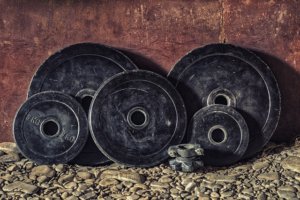
Aerobics and cardio are great for your heart (AKA the “pump” of your cardiovascular system) and sweating, but these exercises don’t break down your muscles much, if at all, and that’s why you don’t regularly feel sore the following day(s).
Compared to weight training, cardio exercises lead to a very short period of increasing your metabolic rate and that’s why we won’t focus on them as the core of fat loss.
Light cardio has its place, and that’s mostly as a two minute warm up to get the blood flowing and lubricate your joints before strength training with weights.
Note: There’s one exception to cardio and that’s HIIT (or High Intensity Interval Training). It delivers more benefits than much longer cardio workouts, but it’s compressed to around 8 to 20 minutes. I highly recommend looking into that or if really interested and can’t find a good resource for it just ask and I can share how I incorporate it into my workouts.
If you choose to go to the gym for your exercise don’t become one of the “crazies”
Lots of really fit people are doing all sorts of exercises in the gym, but unless you know what their goals are and how much time they’re spending in the gym (probably 5 to 7 days a week for at least 60 minutes or more each session for the usual extremely fit crazies) you don’t want to blindly follow them.
Something like half the fit people in most gyms spend too much time in the gym and are overtraining, for some of them it’s their social outlet, some need the ritual, others have made their life about their body and the gym so they spend a ridiculous amount of time their (to feed their egos, reinforce their ideas of themselves and for various personal reasons).
Our goals are different than there’s, so we will do things differently.
We have a specific goal to lose fat and get rid of man boobs so we need to stick to our thing and not get sidetracked by others in the gym.
Another thing you’ll need to watch out for in the gym are people having very narrow goals (e.g. to have big arms and shoulders—stupid, but very common), don’t fall victim to following the gym-lemming syndrome and perpetuate the silliness that leads to having an imbalanced body with big, strong arms and shoulders, and shrimpy little legs and underdeveloped back muscles.
WARNING: The gym is full of some really bad ideas that have been passed on over many decades that people will gladly share with you in gym conversations or if you have questions, so be really cautious and don’t let someone change your plan without having them earn than privilege.
Everyone is different, but the basic exercise principles we’re going to discuss below are pretty damn universal and will get you started in the right direction (if you’re like me and okay with rotating between the same few exercises and a little monotony in the gym you’re better off, since too much exercise variety isn’t necessary, especially since you can change micro-variables like reps, sets, weight, pace, rest, how you structure your sets and weight progressions, exercise order and dozens of other smaller things that’ll keep you busy for decades before having to change up the core exercises you’re doing).
After you hit your goals and want to focus on different body parts THEN you can add some variety, but don’t be like the fools who are doing practically the same exercise over and over again during a session (e.g. bicep curls with barbells, then dumbbell curls, then with the variation of twisting the dumbbell, then cable curls, then biceps curls while standing on their heads, okay the last one was a joke). Once you spend some time in the gym and observe your surroundings you’ll see this play out in many many times.
It comes from the old idea passed down from superfreak bodybuilders that they blast the hell out of the same 1 or 2 muscles during a workout session, but since our goal isn’t to be a “superfreak bodybuilder” it doesn’t make sense to follow their routine.
For some reason a large portion of men in the gym are obsessed with (over)working certain body-parts, like their arms and shoulders—it’s probably because it’s an easier workout (and recovery), media influence and big arms/shoulders can give the illusion of being “big” and fit for the opposite sex (and other competing males).
These same arm/shoulder men are neglecting working their big and important leg and back muscles in a meaningful way and “not getting their money’s worth” in relation to building a strong, useful body and burning loads of fat.
To make sure you’re on the right path here are some of the…
Major Exercise Principles To Shrink Man Boobs
(And That You’ll Get a Lifetime Of Use From)
Exercise Principle #1: Functional movements PERIOD.
Functional, multi-joint movements help your muscles do the most work.
You want to start thinking in terms of exercises that you move the most weight, for the farthest distance, while using the biggest muscle groups. This is your holy grail when it comes to exercise selection (and more importantly, the exercises you will avoid for now till you’re strong, in-shape and lean)
With squats you’re moving lots of weight 1 to 2 feet, and using your big leg and back muscles, which is great.
In contrast, useless exercises for our purpose are calf raises, shrugs or bicep curls, even though you can probably do lots of weight with the first two, you’re only moving the weight a few inches and the muscle groups of your calves, trapezius or biceps are relatively tiny compared to your bigger leg and back muscles.
With bicep curls you’re not moving as much weight and only bending one joint, your elbow, so it’s not a multi-joint movement which incorporates many different muscle groups per exercise and since if you’re like most normal men you don’t want to spend more time in the gym than needed to achieve your goals, you’ll want the exercises that deliver the best results for the least amount of gym/workout time invested (or with the highest ROI, for the geekier men reading). It’ll be intense though.
You’re going to be challenged and get tired regardless of which exercises you do, so best to choose ones that’ll give the most benefits when you’re building your foundation.
Note: After you’ve gotten rid of your man boobs and have lost lots of fat and gained some muscle in the big muscle groups then it’s a different story… At that point if you want bigger arms, shoulders or calves you can work on those with (less efficient) exercises that specifically target those muscles, while still keeping these principles in mind. We’re trying to get from A to B right now, that’s why we’re avoiding C, D, E, F… Since those are currently distractions for where you’re currently at.
The goals with exercise at this stage are to maximize overall health, increase fat burning and build some muscle (it’s not about getting huge or ripped).
Exercise Principle #2: Think of exercise like “Investing” (or creating “Debt” if you’re not doing any)
With your body you’re either:
- Investing in it by doing good things like taking care or your health through exercise, moving your body and diet OR
- Creating a Debt that your future (and eventually present) self will have to pay, the price being less energy, stamina, more fat, higher chance for disease, shorter life and a less healthy life to enjoy how you choose
If you don’t want to join a gym you can buy some adjustable dumbbells, resistance bands or just start off with a bodyweight only workout (e.g. push-ups, pull-ups, dips, bodyweight squats, burpees, lunges, homemade deadlifts, mountain climbers, and other exercises you can Google/YouTube), just make sure it’s a functional movement (Google/YouTube that too, since this article is already extremely long).
Exercise Principle #3: Do the exercises properly, using good form
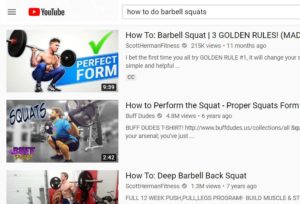 We don’t be going through all the specifics of how to perform each exercise, since that information is widely available by watching YouTube videos, just search “How to do [EXERCISE NAME]” (e.g. How to do barbell squats) and watch 1-3 videos and you’ll get the basics and some tips.
We don’t be going through all the specifics of how to perform each exercise, since that information is widely available by watching YouTube videos, just search “How to do [EXERCISE NAME]” (e.g. How to do barbell squats) and watch 1-3 videos and you’ll get the basics and some tips.
The idea of exercise is to test your body and muscles to improve strength and growth by saying something like this:
“HEY LEGS, you need to suffer a bit to get stronger! It’s going to be difficult, in a good way. Can you handle this?”
To achieve that safely you need to avoid getting carried away with the amount of weight you choose.
One of the big issues with testosterone-filled men exercising is that it’s easy to get caught up in doing more and more weight, but usually what’s being sacrificed is form, which leads to injury—and also not isolating the muscles you intended.
Don’t let your ego influence how much weight to do and definitely don’t “throw” the weights around and use momentum to complete a rep. Instead focus on the main muscles you’re trying to work, think about those muscles and feel them contract and strain as you lift. This gives you the feedback you need to understand if you’re working the right muscles and if the weight you chose works.
If you find the weight is too challenging and you’re getting sloppy, pause and lower the weight, you might think people are watching you (f*ck them if they are, those are usually not the type of people that matter to you) and that you’re less of a man, but you’ll be stronger and healthier 10 years from now.
I don’t want to see you sidelined or turned off of exercise because you got fixated on the wrong goal. It’s not about your ego and impressing others in the gym with male testosterone competitions or showing off for the ladies, it’s about your long term health and happiness.
If you want to send the message home and burn it into your brain to not go crazy with how heavy you go and using proper form, check out the Ronnie Coleman documentary on Netflix, it’s amazing, hard to watch at times and sad, but he’s a true bodybuilding champion, seems sincerely happy and he’s not letting his injuries defeat or define him (although the rewards weren’t worth the long-term cost of his health and basic functioning if you ask me).
It’s a long-term goal and if you want to be healthy and get the most benefit from exercise 10 to 60 years in the future you don’t necessarily need to be moving the most weight in the gym, you just need to work the muscle hard, and if you follow the principle below we’re about to discuss about negative (but good negative, which should be an oxymoron) you’ll need less weight to achieve that…
Exercise Principle #4: Get the NEGATIVE of every exercise repetition
We’re taking precious time out of our lives to go to the gym, so it’s silly if you’re not benefiting from one of the most important parts of exercise, the negative resistance.
You’re probably not familiar with negative resistance since when we think of exercise we think of the effort it takes to get the weight up, but that’s actually less efficient that resisting the weight as it’s going down and not just letting it down with gravity.
By resisting the negative/downward motion of the weight (for most exercises) you’re basically getting twice the benefit and really breaking down that muscle.
A word on those last few reps, those are the ones you might want to give up on or get a little lazy with the negative on. DON’T. The last reps, the ones that are really hard are what helps you grow muscle and burn more fat, since they cause the most stress and will require additional repair (via burning calories in the days following the workout)
You’d think there would be more principles, but that’s the beauty of principles, for many important things in life there are a few big ones, but you get really outsized rewards from them.
Basic workout tips to help connect the dots:
- Try to keep your rest time between sets to one or two minutes (rest times should be shorter and between 20 and 45 seconds between sets for abs and smaller muscles)
- Don’t do more than 12 reps in a set, keep your range of working reps between 6 and 12 (if you can do more than 12 reps it’s time to increase the weight)
- In the beginning aim for 4 to 6 working sets of each exercise (this might change in the future, depending on how you progress and your intensity preferences)
- Do 1 to 2 warm up sets of each exercise before the working sets using lighter weights, while keeping reps between 3 and 5
- BEFORE beginning the actual workout/exercises do a general/functional 4-5 minute warm up (e.g. 2 minutes stationary bike, jumping jacks, air squats and mountain climbers). This is separate from the warm up sets above.
- AFTER the workout do a 5 minute full body stretch
- The last few reps of each working set should be challenging, push yourself a bit
- Make sure you’re hydrated and drinking/sipping plenty of water during workouts, especially when upping the intensity. If you’re drinking Gatorade for electrolytes dilute it with water to 4:1 to minimize sugar/sweeteners
- Let your muscles rest, don’t exercise the same muscle two days in a row (muscles grow during rest/recovery periods and are made with your diet and what goes on in the kitchen/fridge, not in the gym)
- Get enough sleep, since that’s when the bulk of muscle recovery happens
Gym Etiquette on Dropping Weights
Don’t be that fool who’s regularly dropping the weights, there’s usually at least one in the gym, but usually more since it’s contagious when we’re talking about men oozing machismo, low IQs and/or testosterone):
- You came to work out, and unless you’re doing crazy high amounts of weight (I talking setting gym records, not a hard set or rep) get your money’s worth, don’t be a baby and make it a point to lower the weight in a controlled manner (BTW putting it down gently and properly will also get you a little more negative resistance)
- It can also lead to accidents. injuries and damage the equipment. Remember it’s a shared resource, so if you break gym equipment, you’re breaking it for everyone else, not just you
- They think it makes them tougher in that testosterone-filled environment (which is similar to “beer goggles”), but if you really think about it it makes you weaker and more of a pussy (the word fits perfectly in this situation and this post’s mostly for the Y chromosome carriers).
Quick Testosterone Levels Detour
We’re not discussing the medical issue of Gynecomastia man boobs, if you feel that’s your issue it’s something you need to discuss with a doctor.
But as a benefit of exercise you’ll probably avoid the issue of decreased testosterone levels that has plagued modern man, since most of us barely use our bodies. Because of that disuse our amazingly adaptive human bodies are assuming we don’t need much testosterone, so little by little it begins to produce less of it, this is stuff that leads to very big differences between the sexes that define us as men, so it’s serious stuff.
We have been conditioned to believe we’re above using our bodies and that smart, successful people outsource “the dirty, manual stuff”. The thought goes something like this:
“Since I make $xx,xxx (to $xxx,xxx) and the guy/service I’m paying costs a tiny fraction of that it’s a no-brainer to have them do it so I can [sit on my couch and watch more TV, spend more time working, surf the internet on my laptop/tablet, work on my sitting-on-my-ass hobby, or any other use of time…]”.

Don’t be like this couple
This is horrible logic on multiple fronts, but we’re talking TESTOSTERONE here, which is hard to put a price on.
To counteract this modern plague use your body more and sit less, it’s amazing how much we sit and lay down now… Work, Commuting/Driving, TV, Sleep, Waiting for whatever, Breaks from work and this sitting and inactivity getting out of hand.
We were built to move around, hunt, gather, run, jump. Not sit. Sitting leads to being out of shape, unhealthy, fat and we disconnect from what we were built to do.
Things that help testosterone:
- Not Sitting, even in places like “waiting rooms” that you think you’re supposed to sit in (be the weird guy, like me, and make people uncomfortable by walking around and don’t waste an opportunity, stretches or air squats are also good), just move around instead.
- Lifting heavy things and doing Resistance Training, free weights are my favorite, but gym machines (or strenuous outdoor activities) also do the job if they include functional movements that bend more than one joint.
- Get Enough Sleep, my doc told me to start aiming to be in bed for sleep (no TV, phone or tablets) by around 10:30pm, and this has been tremendous for me in terms of feeling rested, which leads to more energy.
- Reduce Stress, I know it’s vague, but the stress hormone cortisol is a real SOB, it makes people fat, while also leeching away your precious testosterone. Meditation or breathing is also good. Working out is also an amazing stress reliever, so it relates to the “Resistance Training” point. Taking time to step back, see the bigger picture and figuring out what’s really important to YOU has a slow but meaningful effect on reducing stress.
- Eat steak! (and other beef) It’s not something I recommend eating weekly for multiple reasons, but it’s useful when you’re trying to boost testosterone levels (Tim Ferriss did an instructive experiment in the 4 Hour Body)
These steps are way better than becoming dependent on testosterone therapy, which I say steer clear from for health and financial reasons, unless you have a serious issue and you’re not able to bring your levels back up or stabilize them with human-friendly options.
Next time you’re doing an annual physical let your doctor know you’re concerned about your testosterone levels (even if you’re not), your medical reasons could be because of lower energy levels, reduced sex drive or fatigue (or a bunch of other things you can quickly Google as legit symptoms). Make sure to also test your “Free Testosterone” levels, and plan the timing of the test so you’re not doing it the day after a workout session, since testosterone levels can be abnormally lower than they actually are after you workout.
Keep track of the levels every year to see how it’s progressing. Make sure you note it somewhere you won’t forget, do this yourself and don’t rely on the doc for keeping track of the long-term trend.
If it’s low for your age talk to your doctor about it and see what (s)he recommends and also talk to him about the bullets above to see what he thinks about trying those for 6 months and retesting the levels before bringing out the “big guns”.
Health Progress Pics—and My Manly Boobs
I don’t have comparable pictures when I was at my biggest, since at the time I wasn’t too excited about taking pictures of myself bare chest when I was 208 lbs. But these should give you an idea of where I was (around 201 lbs) and where I am now (175 lbs). My goals aren’t to be big and ripped, they’re more about overall health, longevity, feeling great, stamina and strength. Because of this I’m not doing exercises that help exaggerate how big I am—like arm or excessive shoulder and chest exercises. Instead i’m focusing on exercises that burn the most calories by working the whole body (i.e. biggest muscles) most completely, while doing the fewest exercises and not spending much time in the gym (i.e. 2 to 3 hours a week). It’s not an apples-to-apples comparison since I’m flexing a bit in some of the “after” pics, but when I’m feeling better and more confident I like to flex sometimes. But it’s real and achievable for most men. And it’s not one of those BS “before” and “afters” that are:
- Photoshopped (all I did was crop them, put them side-by-side and added the words, I didn’t even mess with the color/lighting)
- Gamed with lighting contrast and shadows
- Tanned in the after and pasty white in before
- Messing with dehydration techniques (to highlight very temporary definition for a few hours and then rehydrate to immediately regain 10-20 lbs)
- Cherry picking 1 amazing transformation out of 1,000 using someone that has superfreak genetics
- Using any of the other tricks in the book that are trying to sell you on unrealistic expectations, bordering on fantasy, with minimal effort in short amounts of time (e.g. “transform your body in 30 days).
This is/was me “before and after” style:

Front Shot (about 8 months in between pics). [Yes, I’m furry and proud]
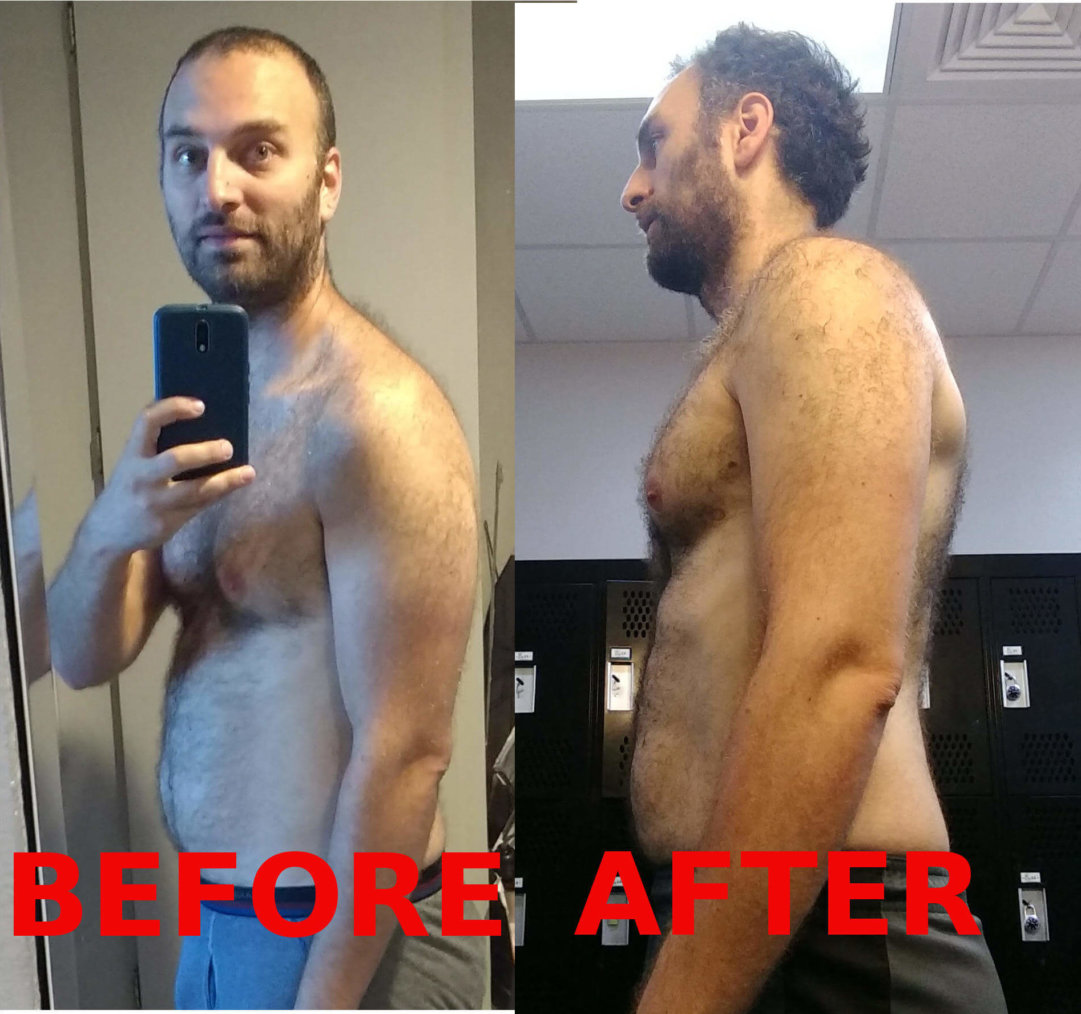
Side Shot (about 7 months in between pics). [And sometimes I go long stretches without shaving or getting a haircut]
I want to reiterate how important it is to take BEFORE pics
It really helps you see how you’ve progressed and how far you’ve come along. Even though I have tons of data in spreadsheets, charts and apps with my weight, food eaten, muscle/fat composition, body-fat %, etc. and I know I’ve improved, but it’s totally different seeing those before and after pics. They really send the message home, offer perspective and make all the effort worth it and more tangible. I’ve never done pics like this. And even though I have a Google Photos album with all my progress pics and seen all these pictures independently, by putting them side-by-side is worth tons and there’s no comparison when tracking long-term progress (i.e. think 6 months, 1 year, 5 years, 20 years, not 2 weeks or 30 days, for shorter periods tracking micro-progress is more valuable). This is MACRO-progress tracking. It’s probably why the cliché of “a picture in worth a thousand words” is so popular.
I’m still hunting down older pics I have where I’m closer to 208 lbs, they’re on one of my older devices or hard drives, just not sure which one or where…
Putting It All Together & Starting To Work The Plan
It’s great that you made it this far. It’s a great sign that you’ll be improving your health and how you look in the coming months.
Here’s a recap of the most important areas we covered to attack pseudogynecomastia (i.e. man boobs due to fat and not the more serious hormone imbalance) and provide an overview to make sense of things and hold everything together:
- It’s a bigger issue than just man boobs and it’s systemic, but we don’t have time to wait for the bigger issues to get fixed so we need to make personal changes
- Need to identify yourself as someone who prioritizes being healthy and strong for life by regularly reminding yourself that you’re someone who eats healthy, exercises and wants to live a long life
- Diet is key and roughly 80-90% of the fat loss equation
- Motivation: Extremely valuable identifying your personal mix of Internal/External motivation and why you’re doing it. Shouldn’t be just about losing man boobs, should be something bigger that losing man boobs fits into. Since if it’s only about man boobs once they’re gone you’ll lose your motivation and slowly add the fat back and have to start over again
- Tracking is your best ally, from pictures, to weight, to taking chest measurements, to temporarily counting calories, it’s this micro-progress tracking that keeps you conscious, empowered—since you’ll realize it all comes down to choices you make—and on track to attain your bigger goals
- Don’t wait till things are perfect, you understand everything or you have things precise. Action is what gets results and too much research delays making progress, jump in now to gain momentum and make adjustments and refinements along the way
- Diet means eating healthy for life and finding your personal diet that you can maintain
- Don’t snack, it’s fine if it’s a small, planned meal and you’re actually hungry, just stick to the good foods from above and stay away from packaged/processed snack foods
- Download MyFitnessPal and start counting your calories temporarily. Commit to doing it for at least a week and then reviewing daily and more in-depth weekly to figure out what you’re doing right, what needs to be tweaked and to understand what you’re eating and how many calories are actually in different foods and how much you’re actually eating
- Metabolism (and keeping it burning fast) and Insulin (and keeping it from spiking) are the missing links that once understood will help you take control of your weight
- Exercise is important, but don’t just do random exercises, do activities and exercises that are big functional movements that raise your metabolism and continue burning fat till at least the next day (hopefully for the next 5 days)
And with that you have plenty to get started.
Remember to take a small step today since it comes down to the positive actions you take. By starting with something small now you’ll begin a habit that will lead to huge long-term health benefits.

You’ll have roadblocks, but if you keep coming back the next day and take another small step you’ll make a meaningful life change.
The good news is it gets easier with practice and repetition.
Need a nudge?
If you’re in (or like 86% there) and want to get started and need a little motivation, clarification, support, additional information, etc. leave a comment or if you want to keep it private go to the contact page and send me a message.
You can also share your goal or motivation in the comments or anonymously (either use a fake name in the comments or message me via the contact page). For many people it’s helpful to just share with someone, anyone, and sometimes a stranger is the perfect person for that.
The act of sharing with others somehow makes it more real and internalizes it for you.
*I’m a data guy, so even though “moobs” is being used lots to find this information we’re going to hope Google doesn’t penalize us for not using that silly term too often and let Google make the connection instead of perpetuating that offensive and humiliating term that downplays the issues and stigmatizes things in a non-productive way. Especially since it’s really not about just the man boobs, it’s about general fat and strength/resistance training to build muscles (not limiting this to chest muscles, but we’ll discuss that more above and end this long footnote here).
**1 pound a week is a good goal if you’re overweight, if you’re obese you probably want to shoot for a higher weekly weight loss goal, since those pounds come off hard and fast when there’s more to lose.
Disclaimer: I’m not a doctor or a health professional and just sharing my opinion and this is not medical advice, just sharing my experiences and findings. And if you feel you have something more serious go see your damn doctor.
Affiliate Disclosure: Some of the links are affiliate links where if you buy something, like from Amazon, where I get paid a small amount, but you get the same price and are not paying more because of this.
